CLASSIFICATION AND DISTRIBUTION OF
SOUTH ATLANTIC RECENT POLYCYSTINE RADIOLARIA1
Demetrio Boltovskoy
ABSTRACT
This paper presents a review of the
current knowledge on the identification and distribution of
Recent polycystine Radiolaria so far recorded, or presumed to
occur, in the South Atlantic Ocean (0° to 60°S, from the South
American coasts to the coasts of Africa). However, because the
area concerned covers from equatorial to Antarctic waters, and
since polycystine radiolarians are geographically (but not
environmentally) cosmopolitan, the review covers most common
species worldwide. Illustrations, short diagnoses, bibliographic
references and distributional data (both geographic and vertical)
are included for 164 polycystine morphotypes (species-groups,
species, and subspecific categories). Introductory remarks offer
general data on radiolarian anatomy, biology, ecology, and
reproduction. Methodological aspects are dealt with in some
detail, with special emphasis being placed on comparative aspects
of the environmental and paleoenvironmental information conveyed
by planktonic materials, sediment trap samples, and sedimentary
deposits. Known or assumed geographic and vertical
species-specific distribution ranges are summarized, as well as
available information on absolute abundances in the water-column
(plankton and sediment trap samples) and in the surface
sediments. The illustrated glossary aimed at the less experienced
student defines the terms and morphological details useful for
diagnostic purposes.
Demetrio Boltovskoy, Departamento
de Ciencias Biológicas, Facultad de Ciencias Exactas y
Naturales, Universidad de Buenos Aires, 1428, Buenos Aires,
Museo Argentino de Ciencias Naturales "Bernardino
Rivadavia", and CONICET, Argentina
KEYWORDS:
Radiolaria, Polycystina, identification, distribution, Recent,
plankton, review
1This article constitutes a modified version
of the chapter "Radiolaria Polycystina", originally
prepared for the book "South Atlantic Zooplankton" (D.
Boltovskoy, ed.), a ca. 2,000 pages guide on the identification
and distribution of 30 zooplanktonic groups to be published in
1999 by Backhuys Publishers, The Netherlands.
1 August 1998
Submission: 31 August 1997, Acceptance: 15 April 1998
http://www-odp.tamu.edu/paleo/1998_2/boltovskoy/issue2.htm
INTRODUCTION
Polycystine radiolarians are
exclusively marine, pelagic, solitary or colonial protists
provided with actinopods. Polycystines comprise the Collodaria, a
small group lacking a skeleton, or provided only with scattered
mono- or polyaxonic spicules; and the Spumellaria and
Nassellaria, most of which have a well developed siliceous
latticed or spongy skeleton (see "Sedimentary vs.
water-column materials.").
Solitary species (the greatest majority) range between 20-30 µm
to about 300 µm, but colonies (some Collodaria and the
spumellarian family Collosphaeridae) may in exceptional cases be
as long as 3 m (Swanberg 1979). The siliceous skeletons of the
polycystines are a major contributor to the sedimentary flux,
their earliest records dating back to the Cambrian. Paleozoic,
Mesozoic and Cenozoic sequences furnish detailed records for
evolutionary, stratigraphic and paleoecologic analyses.
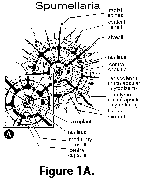 A distinguishing feature of all radiolarians
(polycystines and phaeodarians) is the central capsule, a
proteinaceous perforated membrane that divides the cytoplasm into
two areas: the endoplasm or intracapsular cytoplasm, and the
calymma or extracapsular cytoplasm (Figure 1A).
A distinguishing feature of all radiolarians
(polycystines and phaeodarians) is the central capsule, a
proteinaceous perforated membrane that divides the cytoplasm into
two areas: the endoplasm or intracapsular cytoplasm, and the
calymma or extracapsular cytoplasm (Figure 1A). 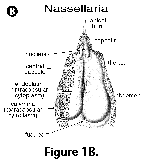 This central capsule is either spherical (in
many Spumellaria), or elongated and pyriform (in most
Nassellaria, Figure 1B). The intracapsular cytoplasm contains
reserve substances and major cytoplasmic organelles (nucleus or
nuclei, mitochondria, and other organelles, except for the
digestive vacuoles), and is generally believed to be responsible
for the functions of reproduction, biochemical synthesis and
energy production. The calymma is the frothy or web-like
extracapsular cytoplasm where the digestive vacuoles are located.
Algal symbionts, when present, are enclosed within vacuoles
usually located in the calymma. Colonial forms have a gelatinous
sheath containing numerous central capsules interconnected by a
rhizopodial network.
This central capsule is either spherical (in
many Spumellaria), or elongated and pyriform (in most
Nassellaria, Figure 1B). The intracapsular cytoplasm contains
reserve substances and major cytoplasmic organelles (nucleus or
nuclei, mitochondria, and other organelles, except for the
digestive vacuoles), and is generally believed to be responsible
for the functions of reproduction, biochemical synthesis and
energy production. The calymma is the frothy or web-like
extracapsular cytoplasm where the digestive vacuoles are located.
Algal symbionts, when present, are enclosed within vacuoles
usually located in the calymma. Colonial forms have a gelatinous
sheath containing numerous central capsules interconnected by a
rhizopodial network.
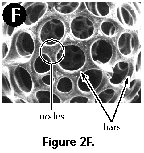 Polycystine skeletons are typically
constructed of a network of structures which can be either
connected at both ends with other elements - the bars (Figure
2F), or formations attached
to the rest of the shell by one end only - the spines (Figure
2A-B, 2G). All skeletal elements are composed of
amorphous silica (SiO2 nH2O). There is
a perplexing variety of shapes in which these bars and spines can
be arranged in order to form the skeleton, from simple latticed
spheres or a few anastomosed spines (Figure 15.119), to elaborate
constructions with several concentric spheres (Figure 2B) or
multilocular conical structures with protruding latticed or solid
appendages known as wings, feet, teeth, etc. (Figure
3O-P, and
3Q-R).
Polycystine skeletons are typically
constructed of a network of structures which can be either
connected at both ends with other elements - the bars (Figure
2F), or formations attached
to the rest of the shell by one end only - the spines (Figure
2A-B, 2G). All skeletal elements are composed of
amorphous silica (SiO2 nH2O). There is
a perplexing variety of shapes in which these bars and spines can
be arranged in order to form the skeleton, from simple latticed
spheres or a few anastomosed spines (Figure 15.119), to elaborate
constructions with several concentric spheres (Figure 2B) or
multilocular conical structures with protruding latticed or solid
appendages known as wings, feet, teeth, etc. (Figure
3O-P, and
3Q-R).
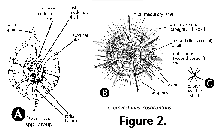 Very
little is known about the reproduction of the Radiolaria. In
addition to vegetative reproduction (Hollande and Enjumet 1953), the production of biflagellated swarmers
was observed, but it is not known if the swarmers are asexual
dissemules or motile gametes (Anderson 1983a). Although no direct estimates have been
made so far, it is generally assumed that individual radiolarian
life spans are around two to four weeks (Anderson 1983a; Caron and Swanberg 1990).
Very
little is known about the reproduction of the Radiolaria. In
addition to vegetative reproduction (Hollande and Enjumet 1953), the production of biflagellated swarmers
was observed, but it is not known if the swarmers are asexual
dissemules or motile gametes (Anderson 1983a). Although no direct estimates have been
made so far, it is generally assumed that individual radiolarian
life spans are around two to four weeks (Anderson 1983a; Caron and Swanberg 1990).
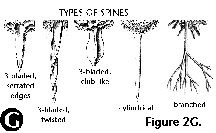 Polycystines consume a wide variety of prey
including bacteria, algae, protists, copepods, appendicularians,
and other small zooplankton (Anderson 1983a, 1993; Caron and Swanberg 1990). Algal symbionts, when present, secrete
photosynthetic products that are assimilated by the host as a
nutritional source (Anderson 1983b).
Polycystines consume a wide variety of prey
including bacteria, algae, protists, copepods, appendicularians,
and other small zooplankton (Anderson 1983a, 1993; Caron and Swanberg 1990). Algal symbionts, when present, secrete
photosynthetic products that are assimilated by the host as a
nutritional source (Anderson 1983b).
The first published descriptions of
Radiolaria date back to the early nineteenth century. Between
approximately 1850 and 1900, C. G. Ehrenberg, J. Müller, R.
Hertwig, A. Popofsky, and especially E. Haeckel described
thousands of new species and provided the first comprehensive
classification systems (Riedel 1967a). After a period of little activity,
interest in the Radiolaria was renewed around 1950, and somewhat
later further fostered by the rich sedimentary materials
recovered by the Deep Sea Drilling Project.
 Because of their application to
stratigraphy, polycystine studies have traditionally been within
the realm of geologists/paleontologists, with
biologically-oriented publications representing less than 10% of
the overall total produced to date (A. Sanfilippo, personal
commun., 1997). The directory included in the 1994 issue of
Radiolaria (Newsletter for the International Association of
Radiolarian Paleontologists) lists 400-plus names; however, only
100-150 of these are primarily concerned with radiolarian
studies.
Because of their application to
stratigraphy, polycystine studies have traditionally been within
the realm of geologists/paleontologists, with
biologically-oriented publications representing less than 10% of
the overall total produced to date (A. Sanfilippo, personal
commun., 1997). The directory included in the 1994 issue of
Radiolaria (Newsletter for the International Association of
Radiolarian Paleontologists) lists 400-plus names; however, only
100-150 of these are primarily concerned with radiolarian
studies. 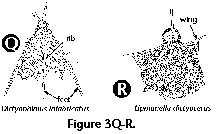 Almost all these workers are geologists
focusing their interest on stratigraphic and paleoceanographic
problems, especially dealing with Paleozoic and Mesozoic
deposits; interest in Cenozoic faunas has been dwindling over the
last few years. Biologically-oriented research based on samples
from the water-column has even fewer specialists, and at present
they are probably less than 10-20 world-wide. Since 1834
approximately 3500 works on polycystine radiolarians have been
published (over half of these on Cenozoic faunas, about 35% on
Mesozoic, and 15% on Paleozoic; A. Sanfilippo, personal commun.,
1997).
Almost all these workers are geologists
focusing their interest on stratigraphic and paleoceanographic
problems, especially dealing with Paleozoic and Mesozoic
deposits; interest in Cenozoic faunas has been dwindling over the
last few years. Biologically-oriented research based on samples
from the water-column has even fewer specialists, and at present
they are probably less than 10-20 world-wide. Since 1834
approximately 3500 works on polycystine radiolarians have been
published (over half of these on Cenozoic faunas, about 35% on
Mesozoic, and 15% on Paleozoic; A. Sanfilippo, personal commun.,
1997).
METHODS
Provenance and collection of materials
Most of the surveys on extant
polycystine radiolarians published to date are based on samples
of their skeletons preserved in the surface sediments, rather
than on plankton samples. Sediment samples have some advantages
over water-column materials, but also several important
shortcomings (see Sedimentary vs.
water-column materials).
A variety of sediment coring and
grabbing devices have been used throughout the years for analyses
of the polycystines from the upper centimeters of the sediments (Kennett 1982). Gravity and Kasten corers are among the
simplest, permitting retrieval of up to a few meters of sediment
at a time from practically any depth. Piston corers have been
used widely due to their ability to recover long sedimentary
sequences, up to 20-30 m in length. However, all these devices
tend to disturb the sediments, especially the uppermost layer
which is of particular importance for the analysis of Recent
assemblages. Box corers (rectangular, shallow, ca. 1 m coring
boxes which ensure complete closure of water-flow passages after
sampling and before leaving the seabed, thus minimizing sample
washout during ascent) are preferable for retrieval of the top
layer of the sediments. However, the fact that box core samples
usually lack the thin uppermost phytodetrital film characteristic
of most sediments (Billett et al. 1983) suggested that the bow-wave of the device
is strong enough as to wash away any mobile particles before
hitting the bottom. Multicorers, an arrangement of several short
coring tubes mounted on a rigid frame seem to overcome this
problem successfully as they have been shown to collect
phytodetritus, as well as significantly higher numbers of
macrobenthic specimens than box corers (Bett et al. 1994).
Plankton samples for radiolarian
studies are usually collected with nets. However, this group, as
well as a few other microzooplanktonic taxa, pose serious
methodological difficulties. Indeed, they are too small (around
20-30 to 300 µm) to collect effectively with standard
zooplanktonic nets (100 to 300 µm in pore size), yet too scarce
in most areas to yield adequate catches with water-bottles or
low-powered pumps. Thus, fine-meshed nets have to be employed,
which significantly complicates not only the concentration of the
radiolarians (due to the concomitant retrieval of other
organisms, some of which, like the diatoms, cannot be fractioned
out later; see Swanberg and Eide 1992), but also because net clogging jeopardizes
subsequent estimations of the volume of water filtered (Tranter and Smith 1968; Boltovskoy 1981b). In order to avoid clogging by smaller
particles, thus ensuring better estimates of the volume of water
filtered and larger sample-sizes, meshes ranging between 60 and
up to 100 µm are traditionally used for polycystine studies in
the water-column. It should be stressed, however, that both
absolute quantitative estimates of radiolarian abundance, and the
proportions of at least some species and developmental stages may
be seriously biased in these collections: Boltovskoy et al. (1993a) reported that in sediment trap materials
from the tropical Atlantic shells below 40-60 µm represent
roughly 50% of the overall polycystine fauna.
Estimates of radiolarian abundances
in the water-column must be performed with flow-metered nets;
clogging of the meshes, in particular of those with small pores,
makes assessment of the volume of water filtered based on
distance towed and mouth diameter extremely unreliable (Tranter and Smith 1968; Boltovskoy 1981a, b). Thus, whenever unflowmetered nets are
employed, such as those derived from Tucker's (1951) opening-closing mechanism (e.g., the
Multinet, based on Bé's 1962, design; the MOCNESS, Wiebe et al. 1976; the RMT 1+8, Baker et al. 1973), it is strongly recommended that
evaluation of radiolarian concentrations be avoided (species
proportions, on the other hand, are in principle unaffected in
these samples).
For assessment of the delicate
colonial forms, as well as for studies of feeding, growth,
metabolism, etc. of live individuals, specimens are collected by
divers (e.g., Swanberg 1979), or by means of very short and slow
plankton tows, thus ensuring a better preservation of the
protists (Matsuoka 1992).
Sediment trap techniques have
undergone major improvements in the last years, thus constituting
a very useful tool for the collection of polycystine materials (US GOFS 1989; Lange and Boltovskoy 1995). Simple sediment traps consist of a
concentrating cone or funnel which tapers into a collecting jar;
the array, which can have either one or several traps, is moored
to the bottom or drifts with the current suspended from a buoy at
the surface. Time-series models are deployed at different oceanic
locations for periods up to a year or more, and are provided with
a mechanism which replaces the collecting cup at predetermined
intervals thus yielding a detailed record of the changes in the
amount and type of flux throughout several seasons (Honjo and Doherty 1988; Lange and Boltovskoy 1995).
Sediment-trap materials have some
important advantages over planktonic collections. Sample-size is
usually much larger in sediment traps than in plankton nets, with
fluxes as high as 200,000 shells/m2/day having been
recorded in the equatorial Atlantic (Boltovskoy et al. 1996; see also table 3 in Boltovskoy et al. 1993a). Seasonal plankton collections are
composed of a sequence of snapshots which represent but an
insignificant proportion of the total time elapsed between tows,
and may therefore not only under- or overestimate mean protist
abundances (e.g., Bé et al. 1985), but also yield "atypical"
specific assemblages. Time-series sediment trap samples, on the
other hand, integrate over preselected depth and time ranges,
thus averaging the overlying plankton over restricted periods
which yield adequate chronological resolution to allow
pinpointing the relative importance of limited offsets of the
yearly cycle. Furthermore, since seasonal variations in total
mass flux are usually closely coupled with primary production in
the upper mixed layer (Honjo et al. 1982, 1988; Deuser et al. 1983, 1990; Wefer 1989), comparison of total flux vs. radiolarian
numbers and specific makeup can furnish first hand information on
indicators (and paleoindicators) of the biological productivity
of the associated water masses.
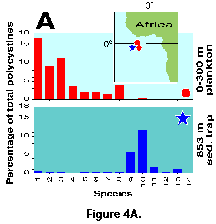 Sediment trap materials, however, also have
some shortcomings. Because of limitations associated with the
hydrodynamic properties of particle accumulation in the traps,
these devices are most effective when deployed at depths in
excess of 500-700 m (US GOFS 1989; Lange and Boltovskoy 1995). As a result, they integrate the flux from
several biologically dissimilar layers (e.g., Kling 1979; Kling and Boltovskoy 1995). Furthermore, sinking skeletons
intercepted at these depths may not adequately reflect their
standing stocks at the surface, nor their specific composition. Boltovskoy and Alder
(1992) concluded that, in
the Weddell Sea, over 90% of the polycystines that inhabit the
upper 400 m are destroyed (probably due to fragmentation by
grazing) before reaching 400-900 m of depth.
Sediment trap materials, however, also have
some shortcomings. Because of limitations associated with the
hydrodynamic properties of particle accumulation in the traps,
these devices are most effective when deployed at depths in
excess of 500-700 m (US GOFS 1989; Lange and Boltovskoy 1995). As a result, they integrate the flux from
several biologically dissimilar layers (e.g., Kling 1979; Kling and Boltovskoy 1995). Furthermore, sinking skeletons
intercepted at these depths may not adequately reflect their
standing stocks at the surface, nor their specific composition. Boltovskoy and Alder
(1992) concluded that, in
the Weddell Sea, over 90% of the polycystines that inhabit the
upper 400 m are destroyed (probably due to fragmentation by
grazing) before reaching 400-900 m of depth.  Subsurface advection of shells produced at
higher latitudes and integration of low protist abundances over
large depth intervals may be responsible for the fact that, in
the eastern equatorial Atlantic, polycystine assemblage
compositions recorded in plankton samples at 0-300 m are totally
different from those recovered in traps at 800-2000 m (Boltovskoy et al. 1995; Figure 4A, 4B).
Subsurface advection of shells produced at
higher latitudes and integration of low protist abundances over
large depth intervals may be responsible for the fact that, in
the eastern equatorial Atlantic, polycystine assemblage
compositions recorded in plankton samples at 0-300 m are totally
different from those recovered in traps at 800-2000 m (Boltovskoy et al. 1995; Figure 4A, 4B).
It should be borne in mind that the
yields of sediment trap samples are not amenable to direct
comparisons with those of plankton samples: while the former are
an expression of the downward flux, which in turn is associated
with productivity and preservation, quantitative plankton samples
give information on standing stock only. Hence, compositional
differences may not only reflect advection, destruction by
grazing, etc., but also biological traits of the species
considered. Thus, a scarce species with high reproduction,
mortality and output rates may be rare in the plankton but
abundant in the underlying sediment trap (Kling and Boltovskoy 1995; Boltovskoy et al. 1995).
As with other zooplanktonic groups,
analyses of radiolarian vertical distribution patterns are
usually performed with the aid of vertically stratified plankton
tows (e.g., Renz 1976; Kling 1979; Dworetzky and Morley 1987; Kling and Boltovskoy 1995; Abelmann and Gowing 1997). However, because their identification is
based on the siliceous skeleton which preserves after the death
of the cell, in order to discriminate live vs. dead protists in
the subsurface layers the cytoplasm is often stained with Rose
Bengal, Sudan black B, or eosin (Petrushevskaya 1971b; Swanberg and Bjørklund
1986; Abelmann and Gowing 1997). Although this technique can furnish some
clues on the living depth ranges of the species, it does not
provide unequivocal information because of uncertainties
associated with the speed of decomposition of the protists'
cytoplasm. Boltovskoy and Lena
(1970), for example,
concluded that specimens of several planktonic foraminifera still
contained protoplasm in their shell 98 days after death. Bernhard (1988) compared estimates of the proportions of
presumably live benthic Foraminifera as indicated by Rose Bengal
and Sudan black B staining and by ATP assay, concluding that
stained protoplasm was present in individuals up to four weeks
after actual death of the cell. These lapses are significantly
longer than the time it takes a radiolarian shell to reach the
sea-floor (Takahashi and Honjo 1983).
Unless special cytological studies
are required (e.g., Petrushevskaya 1986), plankton and sediment trap samples can be
preserved in 4-5% formaldehyde; the addition of picric acid to
the solution enhances the preservation of the colonies, yet
acidification should be avoided if the calcareous plankton is to
be saved from dissolution.
Sample preparation and analysis
The following section offers some
general comments on the preparation of whole samples for routine
counting and identification procedures. It does not review the
methods involved in special cytological and ultrastructural
studies (see Anderson 1983a, for a review of these topics), as well as
those used for detailed taxonomic work, which can involve
thin-sectioning, etching and polishing, etc. (Riedel and Sanfilippo
1977; Boltovskoy et al. 1983; Petrushevskaya 1986).
Pelagic surface sediments are
usually clean enough as to require little treatment before
preparation of the slides. Elimination of the organic matter and
disaggregation of the materials is achieved by boiling the sample
(5-10 g) for a few minutes in a beaker with water to which
hydrogen peroxyde (10%, 300 ml per liter) and tetrasodium
pyrophosphate (10 g per liter) have been added. Disaggregation,
cleaning and removal of clay coatings and infilling particles can
be aided by treating the sample in a gentle ultrasonic bath. For
further disaggregation of heavily indurated sediments various
products, such as kerosene, paint thinner, or ammonia can be
helpful (the sediment is dried, soaked in the solvent, and then
immersed in water, upon which disaggregation usually occurs
rapidly). If calcareous material is abundant it can be removed
with a few drops of hydrochloric acid (after eliminating the
hydrogen peroxyde by wet-sieving). The resulting clean material
is then sieved with abundant water in order to eliminate the
reagents and smaller particles. The mesh size used depends on the
aims of the study; most surveys routinely employ 40-60
µm-meshes, yet these, as described above, miss many of the
smaller species, as well as most developing forms. If precise
abundance estimates are sought, mesh openings around 15 to 20 µm
should be employed, although these will retain large numbers of
unidentifiable skeletal fragments, as well as non-radiolarian
material (especially diatoms), which can make subsequent
observation more laborious. The clean residue in the sieve is
pipetted onto glass microscope slides, dried, and soaked with a
few drops of xylene; before the xylene has evaporated the
mounting medium is added and covered with a cover glass. Canada
Balsam is most often used for these preparations, although it
takes longer to harden than some other synthetic materials,
commercially known as Norland, Pleurax, Hyrax or Depex.
Moore (1973) proposed a convenient method which allows
quantification of the number of radiolarian shells per unit
weight of sediment. Before processing as described above, the
sample is dried and weighed. This weighed sediment is then
cleaned and sieved, and all the resulting residue is poured into
a large (e.g., 5 l) beaker full of distilled water, on the bottom
of which one or two cover gasses have been positioned. The water
with the sediment in the beaker is then thoroughly stirred
(avoiding rotational motion, which will result in centrifugal
fractionation) for achieving a random distribution of the
particles, and the sediment is allowed to settle. With the aid of
a siphon all but 30-50 mm of water are removed, and the remainder
is evaporated with an overhead infrared lamp. When the surface of
the cover glasses is dry they are removed from the beaker and
mounted as described above. The slide thus prepared will contain
a fraction of the radiolarian shells present in the original
sample, this fraction being equivalent to the proportion that the
surface of the cover glass makes of that of the surface of the
bottom of the beaker.
Preparation of plankton and
sediment trap samples is somewhat more labororious due to the
large amounts of organic material they contain. When both
absolute radiolarian concentrations and specific inventories are
sought, it is recommended that counting be performed separately
from the identifications. Polycystines can be counted (although
not identified) in whole, unprocessed samples in counting
chambers under the inverted microscope (Hasle 1978; Boltovskoy 1981c; Villafañe and Reid 1995). Subsequently, either the entire sample or
a subsample can be treated in order to eliminate all organic
matter leaving the clean siliceous skeletons that will be mounted
as described above for sedimentary materials. It should be born
in mind, however, that radiolarian cells are often very difficult
to recognize in preserved, unprocessed plankton samples. The
siliceous skeleton, usually the most conspicuous distinguishing
feature, is obscured by the cytoplasm to such an extent that
radiolarians are easily confused with other planktonic protists,
fecal pellets, eggs, various organic aggregates, debris, etc.
Adding a few drops of hydrogen peroxide and/or hydrochloric acid,
which slowly digest the organic matter, and comparing the dubious
particles before and after treatment can greatly help to pinpoint
radiolarian cells (Alder, personal commun. 1997).
Several different methods have been
used for eliminating organic material from water-column samples,
including high- and low-temperature ashing, oxidizing with
hydrogen peroxide and/or ultraviolet light, etc. (see review in Boltovskoy et al. 1983). One of the most widespread, however, is
that proposed by Simonsen (1974) for cleaning diatom frustules. The plankton
sample is rinsed with abundant fresh water (wet-sieving), and
placed in a beaker to which an equal volume of saturated KMnO4
is added; it is then left for 24 hs. A volume of concentrated HCl
equivalent to that already contained in the beaker is
subsequently added to the sample; the dark brown liquid is gently
heated until it becomes transparent or light yellow. Once the
sample has cooled, it is sieved again thoroughly with fresh water
and rinsed with distilled water. The residue is pipetted onto
microscope glass slides as described above.
 Analysis of the specimens is best performed
in mounted slides, which by transparency permits observing the
internal structures (such as medullary shells, spiral structures,
etc.), and the wall-thickness. In addition, slight variations in
the depth of field allow one to determine whether a shell of
circular outline is a disc (in which case most of the surface is
in focus simultaneously), or a sphere (either the central part or
the periphery are in focus).
Analysis of the specimens is best performed
in mounted slides, which by transparency permits observing the
internal structures (such as medullary shells, spiral structures,
etc.), and the wall-thickness. In addition, slight variations in
the depth of field allow one to determine whether a shell of
circular outline is a disc (in which case most of the surface is
in focus simultaneously), or a sphere (either the central part or
the periphery are in focus). 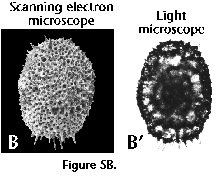 Photographs taken in the light microscope
have the advantage of being readily comparable to mounted
specimens. The scanning electron microscope (SEM), on the other
hand, is especially suitable for analyzing the surface
morphology, but only in specimens with large openings in the
outermost shell, or in those partially broken, can internal
structures be observed. SEM photographs produce very appealing
results, but their comparison with routine collections mounted in
slides is tricky (see Figure 5A, 5B, 5C).
Photographs taken in the light microscope
have the advantage of being readily comparable to mounted
specimens. The scanning electron microscope (SEM), on the other
hand, is especially suitable for analyzing the surface
morphology, but only in specimens with large openings in the
outermost shell, or in those partially broken, can internal
structures be observed. SEM photographs produce very appealing
results, but their comparison with routine collections mounted in
slides is tricky (see Figure 5A, 5B, 5C). 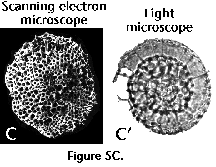 Ideally, both techniques should complement
each other (Boltovskoy et al. 1983, described a method which allows performing
light and SEM observations and photographs of the same
radiolarian specimens).
Ideally, both techniques should complement
each other (Boltovskoy et al. 1983, described a method which allows performing
light and SEM observations and photographs of the same
radiolarian specimens).
Assessment of radiolarian
species-specific absolute and relative abundances are based on
identifications and counts. Since any given slide often contains
thousands of polycystine shells, the researcher is forced to
decide how many specimens should be identified and counted in
order to achieve an adequate estimate of overall numbers and
species proportions. Several methods have been proposed for the
assessment of bias in sample-based particle counts (see reviews
in Venrick 1978, 1995; Frontier 1981), and in the appraisal of species
proportions (Patterson and Fishbein
1989; Buzas 1990). Patterson and Fishbein
(1989) concluded that for
species representing >50% of the overall taxocoenosis at least
50 specimens should be counted in order to achieve reliable
percentage data, 300 counts for species which comprise
approximately 10% of a sample, 500-1000 counts for species that
make up 5%, and counts of several thousands for those that
comprise 1%. Unfortunately, in the case of the polycystines these
efforts are unrealistic because in any given sample containing
100-150 species only one-three are above 10%, and 70-90 occur at
levels below 1% (see "Geographic and vertical distribution"). In terms of the amount of
information attained, it is more profitable to analyze more
samples at a lower resolution, than to examine fewer sites at
these statistically more reliable levels. Thus, in practice
proportions are estimated in bulk, regardless of the individual
species abundances, usually scanning 300-600 specimens per
sample. It is common practice to identify the first 300-600
individuals on the slide, and then check the rest of the slide or
slides for the given sample in order to account for the rarer
taxa. The relative abundances of the latter are estimated
approximately, and they are usually excluded from subsequent
general numerical analyses (e.g., multivariate techniques, such
as cluster and factor analysis) because of the uncertainties
associated with their assumed absences. It should be stressed,
however, that the counting effort necessary for reliable
estimates of the fractional abundance of the rare species is
inversely proportional to the equitability of the assemblage.
Thus, when the sample is strongly dominated by a single or only a
few taxa, such as in polar areas, chances of recording the rare
polycystines in random sequential counts are low because the
observer repeatedly hits the dominant species. On the contrary,
as equitability increases so does the probability of logging a so
far unrecorded species with every new specimen scanned.
GEOGRAPHIC AND
VERTICAL DISTRIBUTION
Sedimentary vs. water-column materials
As opposed to other zooplanktonic
groups, studies on the geographic distribution of extant
polycystines have been chiefly based on sedimentary - rather than
on planktonic - materials. As mentioned above, sediment samples
present some advantages, but also several important shortcomings.
Whereas polycystine abundances
seldom exceed five cells per liter in the plankton (e.g., Caron and Swanberg 1990), one gram of (dry) surface sediments can
contain thousands to hundreds of thousands of radiolarian
skeletons. Plankton samples yield a snapshot-type image of the
composition of the assemblages, which does not necessarily
adequately reflect long-term trends. The daily, seasonal and
interannual variability involved is smoothed out in the
sedimentary record, which may be a welcome trait when general
patterns are sought. Further, sedimentary materials are more
readily available from the various repositories around the globe
than plankton samples. In any case, plankton samples not
collected for microplanktonic purposes may be useless for
radiolarian studies due to inadequate net mesh-size.
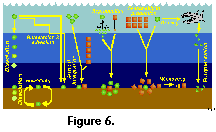 On the other hand, interpretation of the
geographic distribution of extant radiolarian assemblages on the
basis of sediment samples presents several important drawbacks (Boltovskoy 1988, 1994, 1995; Kling and Boltovskoy 1995; Figure 6). On their way to the sea-floor and after
settling, radiolarian remains are grazed upon by various
consumers thus breaking their skeletons into unidentifiable
fragments. Because more delicate shells are destroyed more
readily than the more robust ones, specific makeups on the bottom
and at mid- depths can differ significantly from the living
assemblage in the upper water-column (Boltovskoy et al. 1993b, 1995). Selective dissolution of whole siliceous
skeletons en route to the sea-floor and after deposition,
although often advocated as an important source of plankton vs.
sediments dissimilarities (e.g., Petrushevskaya 1971b; Renz 1976), is probably much less critical than
fragmentation due to grazing (Boltovskoy and Alder 1992; Morley et al. Ms). Bottom materials can be reworked after
deposition (as a result of which non-Recent deposits, sometimes
characteristic of quite dissimilar oceanographic settings, are
brought up to the surface layer, or winnowed by bottom currents
(dislodging settled skeletons and carrying them thousands of
kilometers away; Figure 6). Sediments integrate the imprint of
near-surface faunas (which are generally associated with
surficial temperature, salinity and primary production fields, as
well as with currents and water masses), with the meso- and
bathypelagic species whose geographic distribution is uncoupled
with upper-water oceanography (Figure 6). In general terms the
sedimentary distributions of cold-water species tend to show
conspicuous equatorward extensions as compared with their
planktonic patterns. This distortion is most probably due to the
fact that extended survival of the expatriated cold water taxa is
facilitated by submersion (Boltovskoy 1988, 1994;
Figure 6); as a consequence, sediment-derived species-specific
ranges may wrongly suggest an enhanced tolerance to gradients in
the ecological factors.
On the other hand, interpretation of the
geographic distribution of extant radiolarian assemblages on the
basis of sediment samples presents several important drawbacks (Boltovskoy 1988, 1994, 1995; Kling and Boltovskoy 1995; Figure 6). On their way to the sea-floor and after
settling, radiolarian remains are grazed upon by various
consumers thus breaking their skeletons into unidentifiable
fragments. Because more delicate shells are destroyed more
readily than the more robust ones, specific makeups on the bottom
and at mid- depths can differ significantly from the living
assemblage in the upper water-column (Boltovskoy et al. 1993b, 1995). Selective dissolution of whole siliceous
skeletons en route to the sea-floor and after deposition,
although often advocated as an important source of plankton vs.
sediments dissimilarities (e.g., Petrushevskaya 1971b; Renz 1976), is probably much less critical than
fragmentation due to grazing (Boltovskoy and Alder 1992; Morley et al. Ms). Bottom materials can be reworked after
deposition (as a result of which non-Recent deposits, sometimes
characteristic of quite dissimilar oceanographic settings, are
brought up to the surface layer, or winnowed by bottom currents
(dislodging settled skeletons and carrying them thousands of
kilometers away; Figure 6). Sediments integrate the imprint of
near-surface faunas (which are generally associated with
surficial temperature, salinity and primary production fields, as
well as with currents and water masses), with the meso- and
bathypelagic species whose geographic distribution is uncoupled
with upper-water oceanography (Figure 6). In general terms the
sedimentary distributions of cold-water species tend to show
conspicuous equatorward extensions as compared with their
planktonic patterns. This distortion is most probably due to the
fact that extended survival of the expatriated cold water taxa is
facilitated by submersion (Boltovskoy 1988, 1994;
Figure 6); as a consequence, sediment-derived species-specific
ranges may wrongly suggest an enhanced tolerance to gradients in
the ecological factors.
While these limitations stress the
need for caution in biogeographic interpretations based on
sedimentary materials, the usefulness of bottom samples for
biogeographic, paleobiogeographic and paleoecologic purposes has
been confirmed in many reports and is certainly beyond doubt.
Furthermore, when compared with water-column materials,
sedimentary ones can furnish much useful distributional and
ecological data (e.g., Boltovskoy et al. 1993b; 1995), usually unavailable from plankton or
sediment trap samples alone.
Geographic patterns
Polycystines are typically
open-ocean organisms, occurring throughout the World Ocean.
However, distinct coastal associations, while uncommon or absent
altogether in areas with an extended shelf, such as the
Southwestern Atlantic (Boltovskoy 1980), have been described in various studies.
For example, Norwegian fjords host dense and diverse radiolarian
assemblages, which differ from those of the open Norwegian Sea (Swanberg and Bjørklund
1986, 1987, 1992). Interestingly, two of these fjord
species, Rhizoplegma boreale (probably synonymous with Spongosphaera
streptacantha), and Phormacantha hystrix/Plectacantha
oikiskos, have been found to strongly dominate (up to 47% of
all polycystines) shallow, coastal sediments around Antarctica (Nishimura et al. 1997). General differences between presumably
neritic vs. oceanic radiolarian assemblages have been described
occasionally in the literature (Kruglikova 1984), and even used for paleoenvironmental
reconstructions (e.g., Palmer 1986). However, with the probable exception of
specific diversities, which indeed seem lower in neritic
assemblages (Nishimura et al. 1997), and the fact that a few selected
polycystines are probably less intolerant to near-shore
conditions than the bulk, most other traits (such as
Spumellaria:Nassellaria proportions, percentages of
Spongodiscidae, percentages of "spiny Porodiscidae",
percentages of small "Cyrtoidea"; cf. Kruglikova 1984) need further confirmation.
 Polycystine densities are typically around
0.3-1 cells per liter, but values exceeding 50 ind. l-1
have been recorded in some productive areas (Caron and Swanberg 1990). The quantitative distribution of
polycystines in surface sediments of the South Atlantic is
illustrated in Figure 7. This pattern is probably an approximate
representation of their concentrations in the water-column as
well, and it also roughly reflects the overall distribution of
primary production (e.g., Koblentz-Mishke and
Vedernikov 1977), and of
phytoplanktonic (Semina 1977) and zooplanktonic (Bogorov et al. 1968) biomasses. Highest numbers of polycystines
would thus be expected along the upwelling areas off Africa (Abelmann and Gowing 1997), where the highest radiolarian fluxes have
been recorded to day (Boltovskoy et al. 1996), and in the equatorial current system. In
the southern part of the ocean high densities are probably
associated with the subantarctic belt and its northern
extensions, the Malvinas (=Falkland) and the Benguela Currents.
In a transect between the Antarctic and approximately 30°S,
10°E (off Namibia), Abelmann and Gowing
(1997) recorded highest
polycystine densities at 100-300 m in Antarctic waters, and at
0-150 m in subantarctic waters (up to 0.3 ind. l-1;
these values, however, may be somewhat underestimating, see Boltovskoy and Alder 1992) . In the Southwestern Atlantic (30-60°S,
along 55°W), surface (5-15 m) layers were found to host 0.5
polycystines per liter on the average, with maximum
concentrations of three shells per liter (Alder et al. 1997). Lowest numbers are those present in
Central Gyre and Tropical/Subtropical waters (see Figure 7).
Polycystine densities are typically around
0.3-1 cells per liter, but values exceeding 50 ind. l-1
have been recorded in some productive areas (Caron and Swanberg 1990). The quantitative distribution of
polycystines in surface sediments of the South Atlantic is
illustrated in Figure 7. This pattern is probably an approximate
representation of their concentrations in the water-column as
well, and it also roughly reflects the overall distribution of
primary production (e.g., Koblentz-Mishke and
Vedernikov 1977), and of
phytoplanktonic (Semina 1977) and zooplanktonic (Bogorov et al. 1968) biomasses. Highest numbers of polycystines
would thus be expected along the upwelling areas off Africa (Abelmann and Gowing 1997), where the highest radiolarian fluxes have
been recorded to day (Boltovskoy et al. 1996), and in the equatorial current system. In
the southern part of the ocean high densities are probably
associated with the subantarctic belt and its northern
extensions, the Malvinas (=Falkland) and the Benguela Currents.
In a transect between the Antarctic and approximately 30°S,
10°E (off Namibia), Abelmann and Gowing
(1997) recorded highest
polycystine densities at 100-300 m in Antarctic waters, and at
0-150 m in subantarctic waters (up to 0.3 ind. l-1;
these values, however, may be somewhat underestimating, see Boltovskoy and Alder 1992) . In the Southwestern Atlantic (30-60°S,
along 55°W), surface (5-15 m) layers were found to host 0.5
polycystines per liter on the average, with maximum
concentrations of three shells per liter (Alder et al. 1997). Lowest numbers are those present in
Central Gyre and Tropical/Subtropical waters (see Figure 7).
Flux rates of radiolarian shells at
depths between 50 and ca. 5000 m vary from 0-4 to over 100,000
ind./m2/day (Boltovskoy et al. 1993a), with highest numbers having so far been
recorded in the north-eastern tropical Atlantic (201,064 shells/m2/day;
cf. Boltovskoy et al. 1996).
 The numbers of species that inhabit the
different climatic zones of the World Ocean are difficult to
estimate because most authors restrict their scopes to some 20-40
more or less well-defined morphotypes, ignoring the rest of the
species. The few surveys that (presumably) did attempt to
identify all the skeletons recorded indicate that these numbers
oscillate around 100-200 for the tropics and subtropics, dropping
to some 50-60 at the poles (Figure 8).
The numbers of species that inhabit the
different climatic zones of the World Ocean are difficult to
estimate because most authors restrict their scopes to some 20-40
more or less well-defined morphotypes, ignoring the rest of the
species. The few surveys that (presumably) did attempt to
identify all the skeletons recorded indicate that these numbers
oscillate around 100-200 for the tropics and subtropics, dropping
to some 50-60 at the poles (Figure 8). 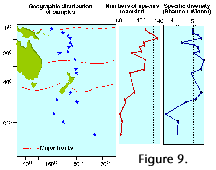 This decrease, however, is often punctuated
by an isolated peak in the transitional areas which usually host
both cold water and warm water taxa, especially in the sediments
(see Figure 9) (Boltovskoy 1981d, 1982, 1986).
This decrease, however, is often punctuated
by an isolated peak in the transitional areas which usually host
both cold water and warm water taxa, especially in the sediments
(see Figure 9) (Boltovskoy 1981d, 1982, 1986).
Despite these rather high numbers,
very few of the species are abundant in any given sample. In
terms of their relative contribution to the overall polycystine
assemblage, usually only one-three species exceed 10%, and up to
five represent over 5%; radiolarians whose average percentage
abundances are below 1% of the fauna usually comprise 70-90% of
all the species recorded (Figure 10). 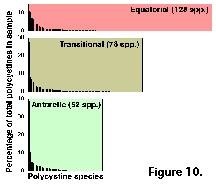 Of the 164 polycystines included in this
review, around 10 can attain average proportions in excess of 10%
in any given area, 12-15 morphotypes can reach 5-7%, and ca.
50-70 are normally around 1-3% (Table 1). The remaining half of the polycystine
species are present at levels below 1%. Highest dominances are
associated with polar environments, where a single species or
species group can account for 25-40% of the assemblage (e.g., Antarctissa
spp. in the Antarctic, cf. Boltovskoy 1987; Amphimelissa setosa in the
Greenland Sea, cf. Swanberg and Eide 1992; Phormacantha hystrix/Plectacantha
oikiskos and Rhizoplegma boreale, probably synoymous
with Spongosphaera streptacantha, in coastal Antarctic
sediments, cf. Nishimura et al. 1997; see Figure 10).
Of the 164 polycystines included in this
review, around 10 can attain average proportions in excess of 10%
in any given area, 12-15 morphotypes can reach 5-7%, and ca.
50-70 are normally around 1-3% (Table 1). The remaining half of the polycystine
species are present at levels below 1%. Highest dominances are
associated with polar environments, where a single species or
species group can account for 25-40% of the assemblage (e.g., Antarctissa
spp. in the Antarctic, cf. Boltovskoy 1987; Amphimelissa setosa in the
Greenland Sea, cf. Swanberg and Eide 1992; Phormacantha hystrix/Plectacantha
oikiskos and Rhizoplegma boreale, probably synoymous
with Spongosphaera streptacantha, in coastal Antarctic
sediments, cf. Nishimura et al. 1997; see Figure 10).
Species-specific distributional
data for the South Atlantic are scarce and fragmentary. Boltovskoy (1981e) produced a detailed listing of all known
Southwestern Atlantic records up to that date, which basically
represented 7 reports (Haeckel 1887; Hays 1965; Nigrini 1967; Goll and Bjørklund 1974; Lozano and Hays 1976; Morley 1977; and Boltovskoy and Riedel
1980), chiefly based on
sedimentary materials. This objective compilation produced a
spotty picture with no discernible patterns. In the 15 years
elapsed since that review several contributions based on South
Atlantic materials appeared, but they mostly focused on downcore
analyses (e.g., Pisias and Moore 1978; Coco 1982; Weaver 1983; Bjørklund and Jansen
1984; Grinstead 1984; Charles and Morley 1988; Alperín 1987), or were restricted geographically to
rather small areas (Robson 1983; Dworetzky and Morley 1987; Boltovskoy et al. 1993a, 1993b, 1995, 1996; Abelmann and Gowing 1997). 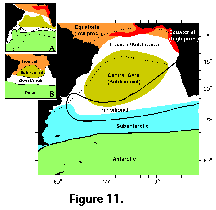 Thus, in order to furnish a more
comprehensive insight into polycystine biogeography in the South
Atlantic, distributional species-specific data are referred to
the 7 distinct areas illustrated in Figure 11). These divisions take into account the
distribution of general planktonic biogeographic provinces (e.g.,
E. Boltovskoy 1970; Koblentz-Mishke and
Vedernikov 1977; Boltovskoy 1979, 1981d,
1982, 1986; Dadon and Boltovskoy 1982; Longhurst 1995), as well as radiolarian-based
biogeographic patterns (Goll and Bjørklund 1974; Morley 1977; see Figure 11, insets A and B). For some
of the especially abundant and better defined taxa relative
(percentage) contributions to all polycystines can be predicted
with reasonable accuracy. For most others, however, only a very
rough indication of their numbers (abundant, present) can be
offered for the time being.
Thus, in order to furnish a more
comprehensive insight into polycystine biogeography in the South
Atlantic, distributional species-specific data are referred to
the 7 distinct areas illustrated in Figure 11). These divisions take into account the
distribution of general planktonic biogeographic provinces (e.g.,
E. Boltovskoy 1970; Koblentz-Mishke and
Vedernikov 1977; Boltovskoy 1979, 1981d,
1982, 1986; Dadon and Boltovskoy 1982; Longhurst 1995), as well as radiolarian-based
biogeographic patterns (Goll and Bjørklund 1974; Morley 1977; see Figure 11, insets A and B). For some
of the especially abundant and better defined taxa relative
(percentage) contributions to all polycystines can be predicted
with reasonable accuracy. For most others, however, only a very
rough indication of their numbers (abundant, present) can be
offered for the time being.
The information used to compile
Table 1 was not restricted to data from the South Atlantic Ocean,
but was extracted from many reports on various oceanic areas,
putting special emphasis on water column-based surveys (see
"Sedimentary vs. water-column materials" above).
Although very subtle differences between oceanic basins probably
do exist (Nigrini 1967; Goll and Bjørklund 1974), polycystine species are chiefly
restricted in their distribution by climatic and productivity
fields, rather than by ocean basins, as are most other pelagic
planktonic organisms. Thus, with very few exceptions, similar
assemblages characterize the equatorial circumglobal belt, the
subtropical zones of the two hemispheres, and the polar waters (Petrushevskaya 1971a). Geographic endemics are rare, probably
accounting for less than 5% of all the species (one outstanding
example is Antarctissa spp., Figure 15.104, which is
absent in the Arctic, but dominates both the plankton and the
sediments of the Antarctic zone).
It should be born in mind that the
degree of mixture between most of the areas shown in Figure 11 is
extremely large. For example, in the western South Atlantic the
Transition Zone stretches up to almost 15 degrees in latitude
(ca. 34-35°S to 47-48°S; Subantarctic species are regularly
found here in the same tows as the Subtropical representatives (E. Boltovskoy 1970, 1981a,
1981b;
E. Boltovskoy et al. 1996). Because the Brazil current is a southwest
flowing branch of the South Equatorial Current, tropical
assemblages differ little from the subtropical ones. Central Gyre
fauna is also very similar to the Tropical and Subtropical one,
yet these oligotrophic waters, characterized by very low overall
plankton abundances, host enhanced proportions of several
colonial radiolarians.
Vertical profiles
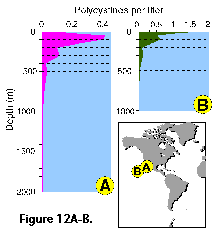 Vertical profiles of total radiolarian
abundance in tropical and subtropical waters indicate that the
bulk of their populations is usually located in the upper 50-100
m (Petrushevskaya 1971b; Renz 1976; Dworetzky and Morley 1987; Kling 1979; Kling and Boltovskoy 1995; Abelmann and Gowing 1997; see Figure 12A-B, 12C, 12F-G). Quite often several discrete maxima are
recorded, one at or near the surface, and a second one between 50
and 100 m (Petrushevskaya 1971b; Kling and Boltovskoy 1995).
Vertical profiles of total radiolarian
abundance in tropical and subtropical waters indicate that the
bulk of their populations is usually located in the upper 50-100
m (Petrushevskaya 1971b; Renz 1976; Dworetzky and Morley 1987; Kling 1979; Kling and Boltovskoy 1995; Abelmann and Gowing 1997; see Figure 12A-B, 12C, 12F-G). Quite often several discrete maxima are
recorded, one at or near the surface, and a second one between 50
and 100 m (Petrushevskaya 1971b; Kling and Boltovskoy 1995).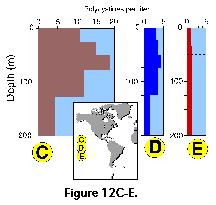 In the Antarctic, however, peak abundances
seem to be associated with the Warm Deep Water and occur deeper,
at 200-400 m (Petrushevskaya 1967; Boltovskoy and Alder 1992; Abelmann and Gowing 1997; Figure 12D, 12E).
In the Antarctic, however, peak abundances
seem to be associated with the Warm Deep Water and occur deeper,
at 200-400 m (Petrushevskaya 1967; Boltovskoy and Alder 1992; Abelmann and Gowing 1997; Figure 12D, 12E).
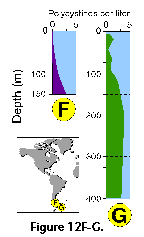 Many radiolarian species occupy discrete
depth intervals of the water column. Kling and Boltovskoy
(1995), on the basis of a
series of plankton tows in the upper 2000 m in the eastern
subtropical Pacific defined the following characteristic layers:
(1) surface (with maxima at 0 m, 25 m, 0 and 50 m, 50 m, or 0 and
100 m), (2) subsurface (maximum at 100 m), (3) deep (maxima at
200 m, 200 and 300 m, or 300 m), and (4) species peaking below
300 m. Roughly similar zonations were established by other
authors as well (e.g., Renz 1976; Dworetzky and Morley 1987; Kling 1979). Worldwide depth zonations, however,
cannot be defined in terms of fixed depths because the
distribution of radiolarian species is related to water masses
which move vertically as well as horizontally. For example, in
the eastern subtropical Pacific inshore and oceanic 0-25 m waters
can host a typically warm-water assemblage associated with the
Central Water which is advected coastward by the Southern
California Eddy, while midway between these two sites the same
depths are inhabited by a conspicuously different, colder-water
assemblage associated with the cooler waters of the California
Current (Kling and Boltovskoy 1995). Many cold water radiolarians that inhabit
the upper layers at high latitudes submerge with their
corresponding water masses and can be found at depth in mid- and
low-latitude areas (Kling 1976; Boltovskoy 1988; Steineck and Casey 1990). Siphocampe arachnea (Figure
15.167), for example, is a dominant component of surface Pacific
Arctic and Subarctic plankton; in the central north Pacific it
peaks at 100-300 m, and at 300-1000 m in the subtropical eastern
Pacific (Boltovskoy 1994).
Many radiolarian species occupy discrete
depth intervals of the water column. Kling and Boltovskoy
(1995), on the basis of a
series of plankton tows in the upper 2000 m in the eastern
subtropical Pacific defined the following characteristic layers:
(1) surface (with maxima at 0 m, 25 m, 0 and 50 m, 50 m, or 0 and
100 m), (2) subsurface (maximum at 100 m), (3) deep (maxima at
200 m, 200 and 300 m, or 300 m), and (4) species peaking below
300 m. Roughly similar zonations were established by other
authors as well (e.g., Renz 1976; Dworetzky and Morley 1987; Kling 1979). Worldwide depth zonations, however,
cannot be defined in terms of fixed depths because the
distribution of radiolarian species is related to water masses
which move vertically as well as horizontally. For example, in
the eastern subtropical Pacific inshore and oceanic 0-25 m waters
can host a typically warm-water assemblage associated with the
Central Water which is advected coastward by the Southern
California Eddy, while midway between these two sites the same
depths are inhabited by a conspicuously different, colder-water
assemblage associated with the cooler waters of the California
Current (Kling and Boltovskoy 1995). Many cold water radiolarians that inhabit
the upper layers at high latitudes submerge with their
corresponding water masses and can be found at depth in mid- and
low-latitude areas (Kling 1976; Boltovskoy 1988; Steineck and Casey 1990). Siphocampe arachnea (Figure
15.167), for example, is a dominant component of surface Pacific
Arctic and Subarctic plankton; in the central north Pacific it
peaks at 100-300 m, and at 300-1000 m in the subtropical eastern
Pacific (Boltovskoy 1994).
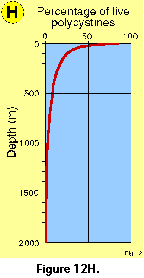 Changes in the proportions of presumably
living polycystine cells with depth have been assessed in a few
studies. Boltovskoy et al. (1993a), based on extensive sediment trap data,
concluded that numbers of live specimens decrease drastically
downwards (e.g., aprox. 100% at 0 m, 50-60% at 100 m, 20-40% at
200 m, 10-20% at 500 m, 5% at 1000 m; see Figure
12H). These results
generally agreee with other studies (e.g., Petrushevskaya 1971a; Kling and Boltovskoy 1995). On the other hand, Abelmann and Gowing
(1997) estimated much
higher proportions of living cells at comparable levels in the
water column: over 90% at 100-200 m, around 70% at 300-500 m. It
should be noticed that staining techniques, which are usually
applied for these estimates, do not adequately differentiate
between live and dead cells (see above "Provenance and
collection of materials"), for which reason it is probable
that concentrations of living specimens below 50-100 m are
systematically overestimated in such surveys (Boltovskoy et al. 1993a; see Figure 12H).
Changes in the proportions of presumably
living polycystine cells with depth have been assessed in a few
studies. Boltovskoy et al. (1993a), based on extensive sediment trap data,
concluded that numbers of live specimens decrease drastically
downwards (e.g., aprox. 100% at 0 m, 50-60% at 100 m, 20-40% at
200 m, 10-20% at 500 m, 5% at 1000 m; see Figure
12H). These results
generally agreee with other studies (e.g., Petrushevskaya 1971a; Kling and Boltovskoy 1995). On the other hand, Abelmann and Gowing
(1997) estimated much
higher proportions of living cells at comparable levels in the
water column: over 90% at 100-200 m, around 70% at 300-500 m. It
should be noticed that staining techniques, which are usually
applied for these estimates, do not adequately differentiate
between live and dead cells (see above "Provenance and
collection of materials"), for which reason it is probable
that concentrations of living specimens below 50-100 m are
systematically overestimated in such surveys (Boltovskoy et al. 1993a; see Figure 12H).
As with geographic patterns, data
on the depths at which the various species peak listed in Table 1
have been compiled from reports on different oceanic areas. It is
anticipated that they are generally valid for subtropical and
tropical environments worldwide; at higher latitudes, however,
some deep species may occur closer to the surface, while in the
Antarctic the bulk of the asssemblages seems to occupy deeper
layers (see above).
TAXONOMY
Morphology and classification
systems
 Based on his previous monograph of 1862, and
especially on the extensive collections of HMS Challenger,
Haeckel (1887) produced the first comprehensive system of
radiolarian classification, encompassing over 3,000 species,
2,400 of which were new to science. Although Haeckel's work is
still a compulsory reference guide for anyone attempting to deal
with the identification of these organisms, it has for some time
been evident that it does not satisfactorily represent natural
relationships. Indeed Haeckel’s groupings are only based on
morphological similarities without the support of continuity in
the fossil record, rather than on demonstrable evolutionary
sequences. In addition, the rigidity of his diagnoses, based
chiefly on strict geometric considerations (Figure
13), ignores the ample
intraspecific variability of the polycystines. As a result, many
of his described "species" are but slightly different
morphotypes or even developmental stages of the same organism
(see Figure 13 and Figure 14).
Based on his previous monograph of 1862, and
especially on the extensive collections of HMS Challenger,
Haeckel (1887) produced the first comprehensive system of
radiolarian classification, encompassing over 3,000 species,
2,400 of which were new to science. Although Haeckel's work is
still a compulsory reference guide for anyone attempting to deal
with the identification of these organisms, it has for some time
been evident that it does not satisfactorily represent natural
relationships. Indeed Haeckel’s groupings are only based on
morphological similarities without the support of continuity in
the fossil record, rather than on demonstrable evolutionary
sequences. In addition, the rigidity of his diagnoses, based
chiefly on strict geometric considerations (Figure
13), ignores the ample
intraspecific variability of the polycystines. As a result, many
of his described "species" are but slightly different
morphotypes or even developmental stages of the same organism
(see Figure 13 and Figure 14).
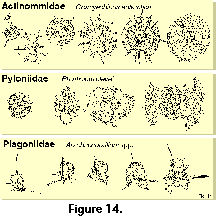 In spite of these shortcomings and the time
elapsed, advances in the development of a better classification
system have been very limited. Efforts to depart from and improve
upon the classification schemes inherited from earlier workers
have mainly followed two different approaches: cytological
techniques and evolutionary studies.
In spite of these shortcomings and the time
elapsed, advances in the development of a better classification
system have been very limited. Efforts to depart from and improve
upon the classification schemes inherited from earlier workers
have mainly followed two different approaches: cytological
techniques and evolutionary studies.
Hollande and Enjumet
(1960), Cachon and Cachon (1972), Petrushevskaya et al.
(1976), Petrushevskaya (1981) proposed revisions which use not only the
skeleton (as most other classifications), but also cytoplasmic
features, in particular the "nucleoaxopodial complex"
(sensu Petrushevskaya 1981). Although these schemes are probably
sounder in biological terms, their applicability to fossil and
subfossil materials lacking the protoplasm is problematic, which
is one of the reasons for their very limited acceptance among
radiolarian workers.
Analyses of evolutionary lineages
in geological sequences were somewhat more succesful than
cytological techniques in defining characters applicable to
classification. Based on evolutionary evidence, Riedel and Sanfilippo
(1986) produced an
interesting critical review of the most important skeletal traits
used by Haeckel. They concluded that some of them (e.g., number
of segments, number of supplementary concentric spheres, number
of feet, number of rays and of equatorial spines in discoidal
Spumellaria, presence and nature of thoracic wings) have little
or no suprageneric value. In contrast, several others (especially
cephalic structure, but also pore arrangement, shell terminations
in Nassellaria, etc.), traditionally considered as of minor
value, are conservative through time, reveal evolutionary
lineages and, therefore, are relevant for higher-rank divisions.
Riedel (1967b, 1971),
Petrushevskaya (1965, 1971a),
Goll (1968, 1969),
Sanfilippo and Riedel
(1970), Zhamoida and Kozlova
(1971), Foreman (1973), Dumitrica (1988, 1989)
based on skeletal features alone worked out alternative
classifications, either for the entire order or for selected
polycystine groups. Of these, Riedel's (1967b, 1971)
suprageneric system has become the most widely accepted for
extant and Cenozoic radiolarians, and is the one adopted herewith
(with slight modifications; see also Kling 1978; Boltovskoy 1981e; Anderson et al. 1996). It should be stressed, however, that this
system does not overcome many of the above-mentioned problems,
and is therefore a compromise provisional classification. Several
of the family-level definitions, especially in the Spumellaria,
are rather vague and generally used as a lumping black box for
the many forms with complex morphologies and poorly understood
relationships (e.g., Litheliidae, Pyloniidae, Tholoniidae).
Specific identification of the
polycystines is a time-consuming and frustrating task. With the
exception of the few abundant and widespread species on whose
names there is fairly good agreement, binomial nomenclature alone
very often fails to pinpoint unequivocally a given morphotype
because different names are applied to the same species and,
conversely, identical organisms are reported under different
specific and even generic names (see Boltovskoy and
Jankilevich 1985). Because
a very substantial proportion of the original species
descriptions were published in old and often hard to get
monographs, some authors find it faster and easier to create a
"new species" for the unusual-looking skeleton in the
slide, than to comb the dusty books in search of an adequate,
already established name. Ecologically, paleoecologically and
stratigraphically-oriented studies often underestimate the
importance of a stable and consistent naming system; the lack of
species illustrations in these reports allows the wrong
designations to go undetected. This not only hinders buildup of
useful information, but also significantly degrades the overall
quality of radiolarian-based data for other applications. Recent
literature has abundant examples of this bias, which introduces
even more chaos into the already anarchic situation inherited
from turn of the century works. Indeed, this may be a major
reason for the waning use of radiolarians in stratigraphic and
paleoecologic work.
The following illustrated glossary
of most commonly used terms for the description of polycystine
skeletons is chiefly based on the listing compiled by Petrushevskaya (1981). Capital letters (in parentheses) denote
the group for which the term is used (N: Nassellaria; S:
Spumellaria).
 Abdomen (N) (Figure 3O, 3P): the third segment of nassellarian
multisegmented shells.
Abdomen (N) (Figure 3O, 3P): the third segment of nassellarian
multisegmented shells.
- Aboral, aboral pole (N):
skeletal section located at the opposite extreme of the
mouth or aperture. Nassellarian growth starts with this
part of the skeleton.
- Annular strictures: see
strictures.
- Antecephalic chamber: see
antecephalic lobe.
- Antecephalic lobe (N) (Figure 3M, 3N):
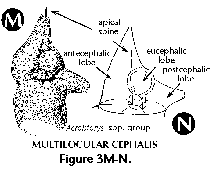 Section of the cephalis at the base
of which the dorsal spine is located. Separated from the
eucephalic lobe by the apical spine. When this section is
separated from the rest of the shell by a pored wall it
is called the antecephalic chamber.
Section of the cephalis at the base
of which the dorsal spine is located. Separated from the
eucephalic lobe by the apical spine. When this section is
separated from the rest of the shell by a pored wall it
is called the antecephalic chamber.
- Apical cupola: see galea.
- Apical horn (N) (Figure 3P): external extension of the apical
spine.
- Apical pore (N): wall-pore
located at the base of the apical spine.
- Apical spine (N) (Figure 3A, 3B):
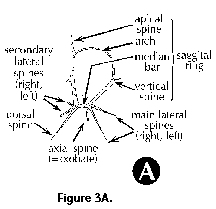 Internal cephalic spine which
branches off the median bar close to the point of
insertion of the dorsal spine. The apical spine can
protrude outside of the cephalis, in which case its
external section is called apical horn.
Internal cephalic spine which
branches off the median bar close to the point of
insertion of the dorsal spine. The apical spine can
protrude outside of the cephalis, in which case its
external section is called apical horn.
- Apical tube (N) (Figure 3J): Tube-like projection on the
cephalis of the Artrostrobiidae, homologous to the
vertical spine. Also termed lateral tube or tubule.
- Apophyses (N, S): any external
or internal protruding outgrowth of the skeletal
meshwork.
- Appendages (N): any external
or internal protruding outgrowth of the skeletal
meshwork. Riedel and Sanfilippo (1986) suggested that
primary appendages (those directly connected to or having
homologies with the internal spicule) are of higher
phylogenetic significance than the secondary ones (not
directly related to the internal spicule).
- Arches (N): anastomosed
skeletal outgrowths of the main spines, such as the one
forming the upper section of the sagittal ring (Figure
3A).

- Areolate (N, S): Referring to
small, very regularly repeated wall perforations or
pores.
- Arms (S) (Figure 2Q, 2R): elongate projections (usually 3)
radiating from a central subcircular disc in the shells
of some Spongodiscidae. Arms can consist of unstructured
spongy meshwork (Figure 2Q), or of spongy meshwork with
more or less clearly visible chambered rings (Figure 2R).
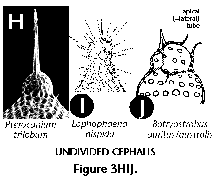
- Axial rod: see axial spine.
- Axial spine (N) (Figure 3A,
3B): spine projecting from the median bar and oriented
toward the thorax and subsequent segments; can be simple
or branched. Also called axobate.
- Axobate: see axial spine.
- Axoneme (N, S): the central
shaft of parallel microtubules of the axopodia
(cytoplasmic structure).
- Axoplast (N, S) (Figure 1A):
central nucleus of the axopodial system (cytoplasmic
structure).
- Bars (N, S) (Figure 2F):
siliceous anastomosed beams that define the meshwork of
polycystine shells, separated by pores.
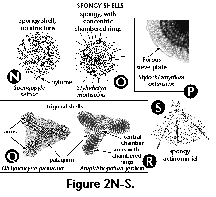
- Basal plate: see collar plate.
- Basal pores (N): see collar
pores.
- Basal ring (N) (Figure 3C):
the subcircular structure formed by the arches that
separate the wall of the cephalis from that of the
thorax. In reduced skeletons, such as those of the
Spyrida, these arches make an actual ring, whereas in
other families the ring is embedded into the shell-wall.
- Basal segment (N): the last
segment in multisegmented Nassellaria.
- Beams (S): siliceous rods
joining contiguous shell structures. In some families
(e.g., Actinommidae, Pyloniidae, Litheliidae) radial
beams connect the successive, concentric spheres (Figure 2A) or consecutive whorls of the
spiral (Figure 2L).

- Branched spines: see spines.
- Calymma (N, S) (Figure 1A):
extracapsular cytoplasm (see central capsule).
- Central capsule (N, S) (Figure
1A, 1B): an organic, perforated membrane within the
radiolarian protoplasm which separates the intracapsular
cytoplasm from the extracapsular one.
- Central chamber (S) (Figure
2R): the central, spherical structure of the skeleton of
several Spongodiscidae.
- Cephalis (N): the first
(uppermost) segment of the skeleton, which can be either
undivided (Figure 3H, 3I, 3J), or divided into lobes or
chambers (Figure 3K, 3M, 3N). The cephalis can be well
differentiated from the thorax (Figure 3F, 3H, 3I, 3J, 3K, 3L, 3M, 3N, 3R), or it can be immersed into it
partially (Figure 3D) or totally (Figure 3E).
- Cervical apophyses (N):
lateral outgrowths of the dorsal spine.
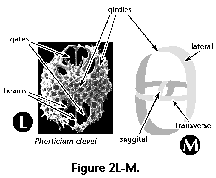
- Cervical pores (N): paired
pores in the base of the cephalis between the primary
lateral and the dorsal spines.
- Cervical stricture (N) (Figure
3O): furrow or constriction which divides the cephalis
from the thorax.
- Chamber (N): one of the
several sections into which the cephalis of the
Nassellaria can be divided (see antecephalic, lateral,
eucephalic and postcefalic chambers). See also central
chamber.
- Chambered rings (S) (Figure
2O, 2R): Concentric or spiral more or less visibly
segmented rings around the central chamber in several
Spongodiscidae (see arms).
- Club-like spines: see spines.
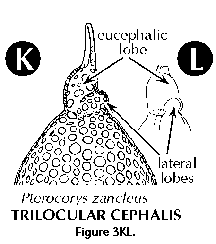
- Collar plate (N): the complex
structure at the base of the cephalis formed by the
spines and arches, all lying on approximately the same
plane.
- Collar pores (N) (Figure 3C):
pores in the collar plate.
- Collar stricture: see cervical
stricture.
- Columella (N): free portion of
the apical spine (Figure 3A) in the cephalis of the
Nassellaria.
- Cortical shell (S) (Figure 2A,
2B): one of the outermost perforated spherical shells of
the Spumellaria, located outside of the central capsule.
- Cupolae (S) (Figure 2C):
dome-like protuberances of the skeleton of the
Tholonidae.
- Cylindrical spines: see
spines.
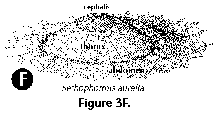
- Dorsal spine (N) (Figure 3A,
3B): Internal cephalic spine projecting from the median
bar at the opposite end of the vertical spine, next to
the apical and secondary lateral spines. The dorsal spine
can protrude outside of the cephalis at the level of the
cervical stricture.
- Equatorial plane (S): mainly
applicable to lenticular, discoidal and biconvex
spumellarian shells (Figure 2H, 2I); plane of maximum shell
surface.
- Eucephalic lobe (N) (Figure
3N): in species with a divided cephalis, the section
which hosts the median bar.
- Extracapsular cytoplasm: see
calymma.
- Feet (N) (Figure 3Q): External
projections of the wall of the thorax oriented down and
sideways, usually in the number of 3. The feet are often
associated with the dorsal and primary lateral spines.

- First shell (S) (Figure 2A,
2B): the innermost shell of the set of concentric spheres
of an actinommid. Sometimes also applied to members of
other families with several successively larger shells
totally or partially enclosing one another. Shells are
numbered from the inside of the skeleton toward the
periphery; thus, the second shell is the one located next
to- and outside of the first one, and so on.
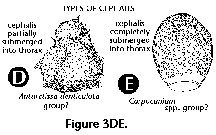
- Fourth shell: see first shell.
- Frames (N, S) (Figure 2D): ridges on the surface of the
shell surrounding the pores. Frames around pores can be
roundish or polygonal (pentagonal, hexagonal, etc.).
- Fundamental spicule: see main
spicule.
- Funnel-shaped pores (N, S):
pores the external opening of which is conspicuously
wider than the internal one.
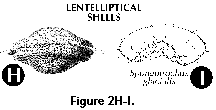
- Galea (N): helmet-shaped
portion of the shell of the Nassellaria associated with
the apical horn; its base is formed by the top of the
cephalis. Also called apical cupola.
- Gates (S) (Figure 2L, M):
large openings in the skeleton's meshwork, usually
conspicuously larger than the pores (Pyloniidae).
- Girdles (S) (Figure 2L, 2M):
circular or ellipsoidal skeletal perforated plates
arranged in three mutually perpendicular planes which
form the skeleton of the Pyloniidae.
- Internal spicule: see main
spicule.
- Intracapsular cytoplasm: see
central capsule.

- Jugal pores (N): paired pores
in the base of the cephalis between the primary lateral
and the vertical spines.
- Lateral lobes (N) (Figure 3K,
3L): lateral sections of the cephalis separated from the
eucephalic portion by cephalic arches.
- Lateral spines (N) (Figure 3A,
3B): Paired spines projecting from the median bar. The
main or primary lateral spines (right and left) are
located in the vicinity of the vertical spine, while the
secondary ones (right and left) are inserted close to the
apical spine.
- Lateral tube: see apical tube.
- Latticed meshwork (N, S)
(Figure 2D, 2E, 2J, 2L): siliceous meshwork of bars
separated by regular or irregular pores of variable size,
not spongy in appearance (see spongy meshwork).
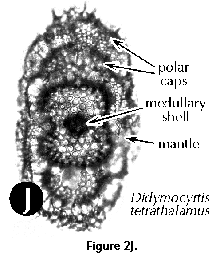
- Lentelliptical shell (S)
(Figure 2H, 2I): in the shape of a biconvex disc.
- Lumbar stricture (N) (Figure
3O): constriction between the thorax and the abdomen.
- Main lateral spines: see
lateral spines.
- Main spicule: see main spines.
- Main spines (N) (Figure 3A,
3B, 3C): basic skeletal elements of most Nassellaria,
composed of the median bar from which the apical,
vertical dorsal and lateral spines arise.
- Mantle (N, S): usually thin,
delicate, lace-like meshwork surrounding the main shell
which appears in some fully grown polycystines.
- Median bar (N) (Figure 3A, 3B,
3C): the basic nassellarian internal skeletal element
which supports the apical, vertical, dorsal and lateral
spines. Its position defines the limit between cephalis
and thorax.
- Medullary shell (S) (Figure
2A, 2B, 2J): one of the innermost perforated spherical
shells of the Spumellaria, located inside the central
capsule. The central smallest sphere (<30 µm) is also
called microsphere by some authors.
- Meshwork (N, S): the
combination of anastomosed rods and bars that form the
external siliceous skeleton of the polycystines.
- Microsphere: see medullary
shell.
- Mitral ring (N): in the
Spyrida, the skeletal ring which lies in the plane
parallel to that of the basal ring and perpendicular to
that of the sagittal ring.
- Monolocular shell (N) (Figure
15.111): Nassellarian shell composed of a single segment.
- Monothalamous shell: see
monolocular shell.
- Mouth (N): A large basal
opening in the last segment of the Nassellaria (also
called aperture), which can be open (Figure 3O, 3P) or
obliterated by a porous plate or velum.
- Multilocular cephalis (N)
(Figure 3K, 3M, 3N): cephalis provided with several
chambers or lobes in addition to the eucephalic one.
- Multilocular shell (N): see
multisegmented shell.
- Multisegmented shell (N)
(Figure 3O): Nassellarian shell composed of several (as
opposed to one) segments.
- Neck (N): elongated section of
shell joining cephalis and thorax.
- Nodes (N, S) (Figure 2F): area
of the shell where two or more bars meet (=nodal points).
- Patagium (S) (Figure 2Q, 2R):
a delicate, spongy meshwork in some Spongodiscidae which
differs from the main shell by its looser structure.
- Peristome (N) (Figure 3P):
differentiated rim around the mouth of the last segment,
usually poreless, often bearing teeth or other
structures.
- Phacoid shell (S): structure
formed by two concentric spherical medullary shells
enclosed in one lenticular cortical shell, characteristic
of the families Coccodiscidae and Phacodiscidae.
- Polar caps (S) (Figure 2J):
Additional skeletal growth in the form of latticed
cupolae at both ends of some coccodiscid shells.
- Pore arrangement (N, S):
spatial distribution of pores of the shell-wall; regular
distributions can be checkered (Figure 3U) or in rows, either transversal
(Figure 3S, 3T) or longitudinal (Figure 3V, 3W).
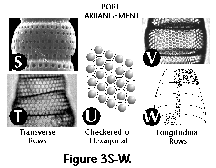
- Pores (N, S) (Figure 2D, 2E):
perforations in the skeleton of the polycystines.
- Porous sieve-plate (S) (Figure
2P): a thin, perforated plate that covers the spongy
surface of some Spongodiscidae.
- Post-abdominal (N) (Figure
3O): refers to structures associated with the fourth and
subsequent segments of multisegmented Nassellaria
(segments, pores, ribs, etc.).
- Postcephalic lobe (N) (Figure
3N): one of the sections into which the cephalis can be
divided, sometimes elongated into a tube.
- Primary lateral spines: see
lateral spines.
- Primary spines: see spines.
- Pylome (S) (Figure 2N): A
larger opening on the external shell of some Spumellaria,
often extending into a tube or surrounded by larger
spines.
- Ribs (N) (Figure 3Q):
elongated, usually unperforated thickenings in the
shell-wall. Sometimes the ribs can extend into wings
(Figure 3R) or feet (Figure 3Q). Dorsal and primary
lateral spines embedded in the wall of the thorax can
also form ribs.
- Rosette-shaped (N, S): usually
applicable to pores with a tri- or tetra-lobed outline
(Figure 2E).
- Sagittal plane (N): the plane
defined by the position of the median bar (and also the
apical, vertical, dorsal and axial spines).
- Sagittal ring (N) (Figure 3A):
a skeletal ring formed by the median bar at the base, the
vertical and apical spines at the front and back,
respectively, and an arch joining these two spines at the
top. It can be either free or embedded into the skeletal
meshwork.
- Second shell: see first shell.
- Secondary lateral spines: see
lateral spines.
- Secondary spines (=
by-spines): see spines.
- Segment (N) (Figure 3O): one
of the several joints or sections which compose a
Nassellarian skeleton, separated by the adjoining ones by
an internal circular thickening of the shell-wall and/or
by an external stricture.
- Septae (N): Well-developed
internal divisions between the segments of nassellarian
shells.
- Sieve-plate: see porous
sieve-plate.
- Spines (N, S): any internal or
external rod or needle with one free end. According to
their relative size and number, spumellarian spines can
be primary (larger, usually fewer in number; Figure 2B)
and secondary (smaller, more numerous, sometimes bristle-
or thorn-shaped; Figure 2B). In cross-section spines can
be triangular (three-bladed) with smooth or serrated
edges, or cylindrical; straight, or twisted (Figure 2G).
The distal end of spines can be unbranched or branched
(Figure 2G). Club-like spines have a swollen or thickened
distal end (Figure 2G). Radial spines are those radiating
centrifugally from the center of the shell (Figure 2B).
- Spongy meshwork (N, S) (Figure
2N, 2O, 2P, 2Q, 2R, 2S): sponge-like (as opposed to
latticed) siliceous meshwork of thin, irregular, more or
less densely packed bars, mainly in some spumellarian
families (Actinommidae, Spongodiscidae).
- Strictures (N) (Figure 3O):
joints between contiguous segments, often marked by
conspicuous external constrictions.
- Teeth (N) (Figure 3P):
protruding apophyses around the mouth, of variable length
and thickness (=oral teeth, adoral teeth, terminal teeth,
subterminal teeth).
- Terminal teeth: see teeth.
- Third shell: see first shell.
- Thorax (N) (Figure 3O, 3P):
second segment of multisegmented nassellarians.
- Tripod (N): section of the
internal skeleton formed by the dorsal and primary
lateral spines (Figure 3A, 3B). In some shells the tripod
protrudes externally forming the feet (Figure 3Q).
- Tubercles (N, S): pustule-like
lumps (condyles, mamillae) on the surface of the
siliceous shell.
- Unilocular shell: see
monolocular shell.
- Velum (N): a porous plate
obliterating the mouth.
- Ventral spine: same as axial
spine.
- Vertical spine (N) (Figure 3A,
3B): Main unpaired spine projecting from the median bar
in the vicinity of the primary lateral spines and the
axial spine.
- Wings (N) (Figure 3R): lateral
apophyses of the thorax usually connected to the
shell-wall by siliceous meshwork, derived from external
projections of the dorsal and primary lateral spines.
Outline classification
The following synopsis, based
chiefly on the scheme proposed by Riedel (1967b, 1971),
is restricted to extant families only. As pointed out above, it
is a provisional classification very likely to change as more
structural and evolutionary data are obtained. Taxa in bold
characters are those treated in detail in this chapter.
Kingdom PROTISTA
Haeckel, 1886
Phylum SARCODINA Hertwig and Lessser, 1876
Class ACTINOPODA Calkins, 1909
Subclass HELIOZOA Haeckel, 1886
Subclass ACANTHARIA Müller, 1858
Subclass RADIOLARIA Müller, 1858
Superorder PHAEODARIA Haeckel, 1879
Superorder POLYCYSTINA Ehrenberg, 1838, emend. Riedel,
1967
Order COLLODARIA Haeckel, 1881
Family
THALASSICOLLIDA Haeckel, 1862
Family COLLOZOIDA Haeckel, 1862
Family THALASSOSPHAERIDA Haeckel, 1862
Family SPHAEROZOIDA Haeckel, 1862
Order SPUMELLARIA
Ehrenberg, 1875
Family COLLOSPHAERIDAE
Müller, 1858, emend. Strelkov and Reshetnjak, 1971
Family ACTINOMMIDAE Haeckel, 1862, emend.
Sanfilippo and Riedel, 1980
Family COCCODISCIDAE Haeckel, 1862 emend.
Sanfilippo and Riedel, 1980
Family PHACODISCIDAE Haeckel, 1881
Family SPONGODISCIDAE Haeckel, 1862, emend. Riedel
1967
Family LITHELIIDAE Haeckel, 1862
Family PYLONIIDAE Haeckel, 1881
Family THOLONIIDAE Haeckel, 1862
Order NASSELLARIA
Ehrenberg, 1875
Family SPYRIDAE
(=Trissocyclidae, Acanthodesmiidae) Ehrenberg, 1847,
emend. Petrushevskaya, 1971
Family PLAGONIIDAE Haeckel, 1881, emend. Riedel,
1967
Family THEOPERIDAE Haeckel, 1881, emend. Riedel,
1967
Family CARPOCANIIDAE Haeckel, 1881, emend. Riedel,
1967
Family PTEROCORYTHIDAE Haeckel, 1881, emend.
Riedel, 1967
Family ARTOSTROBIIDAE Riedel, 1967, emend.
Foreman, 1973
Family CANNOBOTRYIDAE Haeckel, 1881, emend.
Riedel, 1967
Order and family-level diagnoses
Order Collodaria. Solitary
or colonial polycystines without a siliceous skeleton, or
provided with simple or branched spicules scattered in the
calymma. Due to their fragility, members of this group preserve
poorly in net plankton samples, and either do not preserve at all
or are represented only by their spicules in sedimentary
materials. Partly because of these limitations, information on
their classification and distribution is extremely scarce, and no
further details are given herein. Detailed reviews of the
colonial radiolarians, including several Collodaria, were
produced by Hollande and Enjumet
(1953), Strelkov and Reshetnjak
(1971), and Swanberg (1979). Most of these species have tropical
distribution ranges in the three major oceans. In the south
Atlantic they are probably restricted to waters associated with
the equatorial current system, the Tropics/Subtropics, and the
oligotrophic Central Gyre (Figure 11). According to Haeckel (1887), this group comprises four families:
Family Thalassicollida:
solitary cells, no skeletal elements; genera Actissa
(Figure 15.1), Thalassocampe (Figure 15.2), Thalassopila,
Thalassicolla, and Thalassophysa;
Genus Collozoida:
colonial, no skeletal elements; genus Collozoum
(Figure 15.6, 15.7, 15.8, 15.11);
Genus Thalassosphaerida:
solitary, with siliceous spicules scattered in the calymma;
genera Thalassosphaera, Thalassoxanthium
(Figure 15.3), Physematium, Thalassoplancta, Lampoxanthium
(Figure 15.5);
Genus Sphaerozoida:
colonial, with siliceous spicules scattered in the calymma;
genera Belonozoum, Sphaeorozoum (Figure 15.10),
Raphidozoum (Figure 15.12).
Order Spumellaria. Solitary
or colonial radiolarians with a well-developed shell of radial
symmetry or one derived from the above. Variations in the type of
symmetry include spiral shells (e.g., Figure 15.87), asymmetric,
discoidal or lenticular (biconvex) (Figure 2H, 2I; 15.60, 15.61,
15.62, 15.63, 15.64, 15.65), triaxonic (Figure 2Q, 2R),
quadrangular (Figure 15.66, 15.67), etc. In many cases two axes
of symmetry can be clearly differentiated (Figure 2J) but, as
opposed to the Nassellaria, the larger axis is homoaxonic. The
central capsule (organic) of these cells has many small pores.
Family Collosphaeridae.
Colonial polycystines, each individual has a single,
thin-walled, spherical or subspherical latticed shell. The
Collosphaeridae is the only group of colonial polycystines
with complete latticed shells. Colonies consist of a
gelatinous mass (which obviously disappears in the
sedimentary record, as well as in many net-plankton samples
where it breaks down) in which hundreds to thousands of
shells are immersed (Figure 1C, 1D, 1E).  The shape of the colony is not
species-specific; it may be spherical, ellipsoidal,
cylindrical, ribbon-shaped, etc., measuring up to several
centimeters in length and a few millimeters in diameter. The
siliceous shells are always represented by a single
perforated sphere (internal spheres are never present), with
or without centrifugal (external) or centripetal (internal)
tubular projections and/or spines. Spines (when present) are
conical (circular in cross-section). As with most other
polycystines, specific assignments are based almost
exclusively on the skeleton; however, studies of entire
colonies, which allow investigating the intraspecific
morphologic variability of the collosphaerids, indicate that
quite dissimilar shell morphotypes can coexist within the
same colony, thus stressing the assumption that at least some
of the specific divisions based on the siliceous sphere alone
are spurious (e.g., Kleijne 1987; Petrushevskaya and
Swanberg 1990).
The shape of the colony is not
species-specific; it may be spherical, ellipsoidal,
cylindrical, ribbon-shaped, etc., measuring up to several
centimeters in length and a few millimeters in diameter. The
siliceous shells are always represented by a single
perforated sphere (internal spheres are never present), with
or without centrifugal (external) or centripetal (internal)
tubular projections and/or spines. Spines (when present) are
conical (circular in cross-section). As with most other
polycystines, specific assignments are based almost
exclusively on the skeleton; however, studies of entire
colonies, which allow investigating the intraspecific
morphologic variability of the collosphaerids, indicate that
quite dissimilar shell morphotypes can coexist within the
same colony, thus stressing the assumption that at least some
of the specific divisions based on the siliceous sphere alone
are spurious (e.g., Kleijne 1987; Petrushevskaya and
Swanberg 1990).
Family Actinommidae.
Solitary species with latticed or spongy spherical,
subspherical, or ovoid shells (not lenticular); with or
without medullary shells. Surface of shell is often covered
with spines, but not tubes. All actinommids posses either
single or multiple, concentric spherical or ovoid shells.
When several shells are present they are connected to each
other by radial beams which pierce the cell. An enormous
variety of forms was described in this family whose
identification has traditionally been based on Haeckel's (1887) system. Haeckel based the
classification of the actinommids (=suborder Sphaeroidea,
exclusive of the Collosphaerida) on the following characters
(in decreasing order of importance; see Figure 13): 1. Number
of primary radial spines; 2. Number of concentric spheres; 3.
Position of concentric spheres (intra- or extracapsular),
type and relative size of spines, presence of by-spines, type
of medullary shell, etc.). However, the number of primary
spines varies intraspecifically, whereas the number of main
concentric spheres, which within some bounds might indeed be
species-specific (Riedel and Sanfilippo
1986), can only be used
in the case of fully-grown individuals. It is quite obvious
that, based on this trait, Haeckel (as well as many other
authors) assigned new names to growth stages still missing
the outermost sphere(s) (see Figs. 13 and 14). Furthermore,
while growth of an actinommid as far as we know proceeds from
the center toward the periphery (Figure 14, upper panel),
dissolution works in the opposite direction, innermost, more
delicate shells usually disappearing before the more robust
cortical ones. Thus, materials from the sediments offer yet
another suite of "new species", this time missing
the medullary (rather than the cortical) shells.
Family Coccodiscidae
(Figure 2H, 2J). Latticed discoidal or lenticular shell
enclosing a single or double medullary shell, and surrounded
by an equatorial zone of spongy or concentrically-chambered
structures (Figure 2H), or forms with an ellipsoidal cortical
shell equatorially constricted enclosing a single or double
medullary shell (Figure 2J). The formerly actinommid
subfamily Artiscinae was transferred to the Coccodiscidae by Sanfilippo and Riedel
(1980) due to its
phylogenetic affinities with extinct coccodiscids.
Family Phacodiscidae.
Lenticular, biconvex, latticed cortical shell, not surrounded
by spongy or chambered structures, within which a small,
spherical single or double medullary shell is enclosed. The
margin (but less commonly the surfaces) of the cortical shell
may bear radial spines.
Family Spongodiscidae.
Discoidal or cylindrical, spongy or finely chambered
skeleton, with or without surficial pore-plate, often with
radiating arms or marginal spines. The members of this family
are characterized by possessing skeletons which are partly or
entirely spongy in appearance. However, as opposed to the
Actinommidae, which can also have spongy skeletons, the
Spongodiscidae are not spherical. Their overall shape can be
lenticular (biconvex discs, Figure 2I), cylindrical (Figure
15.74), quadrangular or subquadrangular in outline (Figure
15.67), or Y-shaped (Figure 2Q, 2R). With the exception of
the cylinders, all others are depressed or flattened (rather
than circular in cross-section, Figure 2I). Lenticular,
quadrangular, and Y-shaped forms may be entirely composed of
a spongy mass with no discernible structure (in which case
the central part of the skeleton is often thicker and/or
denser, and therefore appears darker in the light microscope;
Figure 2O, 15.64), or may posses a small central chamber
surrounded by concentric or spiral, continuous or interrupted
bands (Figure 2R). The surface of some forms may be partly or
totally covered with a very thin, porous sieve-plate, which
in lenticular forms may extend beyond the central spongy mass
forming a delicate equatorial girdle around the periphery of
the shell (Figure 2P) (these morphotypes were formerly
included in the family Porodiscidae).
Family Litheliidae. The
lattice of the ellipsoidal, spherical or lenticular shell is
totally or partially arranged along a bilaterally symmetrical
spiral. Although very abundant, due to their complicated
architecture the litheliids are poorly known, for which
reason the morphotypes defined may include several different
forms.
Family Pyloniidae. The
major part of the shell is composed of a series of
successively larger elliptical latticed girdles in three
mutually perpendicular planes, with the major diameter of
each girdle being the minor diameter of the next larger one
(Figure 2L, 2M). The center is occupied by a small
ellipsoidal structure - the microsphere (see Dumitrica 1989).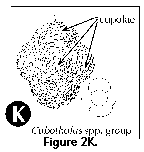
Family Tholoniidae.
Completely latticed shell, without larger openings, and with
constrictions that define several (typically 6) dome-shaped
protuberances (Figure 2K).
Order Nassellaria. Solitary
polycystines with a siliceous heteropolar shell, which can be
represented by several fused spicules only, by a D-shaped ring
and associated spines, or by more elaborate, mono- or
multilocular latticed skeletons. With the exception of a few
forms lacking a well developed skeleton (Figure
15.101, 15.119), the symmetry of this group is
characterized by the fact that the two extremes of the major axis
define two morphologically different poles of the shell. One of
these, conventionally accepted as the top or anterior end, is
where the cephalis is located. A widely recognized, albeit seldom
utilized, feature of primary importance for the classification of
the Nassellaria is the internal skeleton. The internal skeleton
consists of a complex set of spines and connecting bars enclosed
in the cephalis (Figure 3A, 3B, 3C), which allow comparison of
homologous structures in forms differing widely in their external
morphology. Unfortunately, analysis of these features requires
dedicated efforts at understanding the complex spatial
relationships involved. Furthermore, observation of this internal
skeleton is only feasible with well preserved individuals
oriented in the right position, which is seldom the case in
specimens mounted in permanent slides. In addition to the small
scattered perforations typical of the Spumellaria, the central
capsule of the Nassellaria is usually provided with a single
larger pore.
Family Spyridae
(=Trissocyclidae). The skeleton is represented by a
well-developed D-shaped sagittal ring (median bar and
anastomosed vertical and apical spines), either free (Figure
15.101) or embedded into the latticed cephalic wall, in which
case the cephalis is usually bilaterally lobed (Figure 15.93,
15.94, 15.100). Sometimes with thorax, abdomen always absent.
The typical heteropolar nassellarian symmetry is often
inconspicuous in the Spyridae.
Family Plagoniidae.
Skeletons restricted to a simple tri- or tetraxonic
nassellarian spicule (Figure 15.119), or a well developed
system of main spines enclosed within a fully formed cephalis
(Figure 3A, 3B). The degree of development of the cephalis
may vary from a few anastomosed bars (Figure 15.120, 15.124)
to a well developed, latticed or latticed/spongy chamber.
Usually without postcephalic segments. In addition to several
fairly well-defined species, the Plagoniidae comprise many
probably related forms of obscure taxonomic status usually
cited under various generic names (see below). The
classification of these forms needs detailed ad hoc studies,
for which reason many of them are provisionally lumped under
the designation Plagoniidae group in the present
chapter.
Family Theoperidae.
Cephalis spherical or subspherical, relatively small, often
poreless or sparsely perforate. It usually bears an apical
horn. Internal spicule small and inconspicuous. With one or
more, sometimes up to over 10, usually well-developed
postcephalic segments. Generally, cap- or helmet-shaped, or
conical in overall outline.
Family Carpocaniidae.
The small, rudimentary cephalis is usually totally immersed
in the large and well-developed thorax (Figure 3E). Abdomen
absent or rudimentary.
Family Pterocorythidae.
Cephalis large, divided into three lobes by two lateral
furrows directed obliquely and downward from the apical spine
to the base of the cephalis. The upper unpaired lobe is
located above the two smaller paired ones (Figure 3K, 3L);
these basal paired lobes are not always conspicuous. Many
pterocorythids are two or three-segmented, lacking
postabdominal segments.
Family Artostrobiidae.
Spherical or subspherical cephalis, usually with an apical
tube directed obliquely upwards (Figure 3J). The pores on all
postcephalic segments, or at least on the last ones, are
arranged in clearly defined transverse rows (Figure 3S).
Usually elongated, multisegmented forms.
Family Cannobotryidae.
Cephalis large, with several asymmetrical lobes (sometimes
appearing as irregular bulges) (Figure 3M). Mostly
2-segmented forms (cephalis and thorax), but sometimes with
post-thoracic segments.
TAXONOMY
Identification of species
The overall total of living
polycystine species is probably around 300-600, but this review
includes only 164 taxa. Unfortunately, our present state of
knowledge is insufficient for a significantly greater coverage.
All polycystine families need detailed taxonomic work, but some
are especially poorly known (e.g., Actinommidae, Pyloniidae,
Litheliidae, Tholoniidae, Plagoniidae). However, the
inexperienced student should not be discouraged by the fact that
the available literature fails to assist in identifying very
significant proportions of the shells present in any given
sample. As mentioned above, most radiolarian-based ecological and
paleoecological surveys restrict their scope to some 20-40
polycystines, the rest being ignored altogether. Although
coverage of an ampler inventory is clearly desirable, these
restricted databases allow one to draw very valuable
environment-related conclusions. Furthermore, in order to
circumvent identification-related problems, the use of
family-level assignments has been advocated for environmental and
biogeographic analyses (Kruglikova 1981, 1987).
The following section presents
succinct information for the identification of the taxa recorded
in the South Atlantic Ocean, as well as for several others whose
presence in the area is very likely, but has not been confirmed
yet.
When applicable, species names are
followed [in square brackets] by some of the other most common
names under which the form has been recently cited in the
literature. Diagnostic information is provided as short remarks
stressing the characters which help differentiate the taxon from
closely related forms; they are not meant to replace detailed
descriptions, but in most cases these remarks, in combination
with the illustrations, should suffice for producing adequate
identifications of the radiolarians treated. Keys are not
adequate for this particular group due to their lack of
flexibility, and because they are more prone to lead to
misidentifications given the high number of rare polycystine
species not included in this review. Shell size is generally of
minor value for identification purposes, for which reason no
detailed morphometric information is given; the dimensions
specified are approximate and are furnished with the sole purpose
of a general scale reference. The designation "group"
denotes categories of unclear taxonomic affinities, where
probably several related taxa are lumped. For each of the species
treated one or more references ("Ref.") providing
detailed descriptions and illustrations are included.
 A distinguishing feature of all radiolarians
(polycystines and phaeodarians) is the central capsule, a
proteinaceous perforated membrane that divides the cytoplasm into
two areas: the endoplasm or intracapsular cytoplasm, and the
calymma or extracapsular cytoplasm (Figure 1A).
A distinguishing feature of all radiolarians
(polycystines and phaeodarians) is the central capsule, a
proteinaceous perforated membrane that divides the cytoplasm into
two areas: the endoplasm or intracapsular cytoplasm, and the
calymma or extracapsular cytoplasm (Figure 1A).  This central capsule is either spherical (in
many Spumellaria), or elongated and pyriform (in most
Nassellaria, Figure 1B). The intracapsular cytoplasm contains
reserve substances and major cytoplasmic organelles (nucleus or
nuclei, mitochondria, and other organelles, except for the
digestive vacuoles), and is generally believed to be responsible
for the functions of reproduction, biochemical synthesis and
energy production. The calymma is the frothy or web-like
extracapsular cytoplasm where the digestive vacuoles are located.
Algal symbionts, when present, are enclosed within vacuoles
usually located in the calymma. Colonial forms have a gelatinous
sheath containing numerous central capsules interconnected by a
rhizopodial network.
This central capsule is either spherical (in
many Spumellaria), or elongated and pyriform (in most
Nassellaria, Figure 1B). The intracapsular cytoplasm contains
reserve substances and major cytoplasmic organelles (nucleus or
nuclei, mitochondria, and other organelles, except for the
digestive vacuoles), and is generally believed to be responsible
for the functions of reproduction, biochemical synthesis and
energy production. The calymma is the frothy or web-like
extracapsular cytoplasm where the digestive vacuoles are located.
Algal symbionts, when present, are enclosed within vacuoles
usually located in the calymma. Colonial forms have a gelatinous
sheath containing numerous central capsules interconnected by a
rhizopodial network. Polycystine skeletons are typically
constructed of a network of structures which can be either
connected at both ends with other elements - the bars (
Polycystine skeletons are typically
constructed of a network of structures which can be either
connected at both ends with other elements - the bars ( Very
little is known about the reproduction of the Radiolaria. In
addition to vegetative reproduction (
Very
little is known about the reproduction of the Radiolaria. In
addition to vegetative reproduction ( Polycystines consume a wide variety of prey
including bacteria, algae, protists, copepods, appendicularians,
and other small zooplankton (
Polycystines consume a wide variety of prey
including bacteria, algae, protists, copepods, appendicularians,
and other small zooplankton ( Because of their application to
stratigraphy, polycystine studies have traditionally been within
the realm of geologists/paleontologists, with
biologically-oriented publications representing less than 10% of
the overall total produced to date (A. Sanfilippo, personal
commun., 1997). The directory included in the 1994 issue of
Radiolaria (Newsletter for the International Association of
Radiolarian Paleontologists) lists 400-plus names; however, only
100-150 of these are primarily concerned with radiolarian
studies.
Because of their application to
stratigraphy, polycystine studies have traditionally been within
the realm of geologists/paleontologists, with
biologically-oriented publications representing less than 10% of
the overall total produced to date (A. Sanfilippo, personal
commun., 1997). The directory included in the 1994 issue of
Radiolaria (Newsletter for the International Association of
Radiolarian Paleontologists) lists 400-plus names; however, only
100-150 of these are primarily concerned with radiolarian
studies.  Almost all these workers are geologists
focusing their interest on stratigraphic and paleoceanographic
problems, especially dealing with Paleozoic and Mesozoic
deposits; interest in Cenozoic faunas has been dwindling over the
last few years. Biologically-oriented research based on samples
from the water-column has even fewer specialists, and at present
they are probably less than 10-20 world-wide. Since 1834
approximately 3500 works on polycystine radiolarians have been
published (over half of these on Cenozoic faunas, about 35% on
Mesozoic, and 15% on Paleozoic; A. Sanfilippo, personal commun.,
1997).
Almost all these workers are geologists
focusing their interest on stratigraphic and paleoceanographic
problems, especially dealing with Paleozoic and Mesozoic
deposits; interest in Cenozoic faunas has been dwindling over the
last few years. Biologically-oriented research based on samples
from the water-column has even fewer specialists, and at present
they are probably less than 10-20 world-wide. Since 1834
approximately 3500 works on polycystine radiolarians have been
published (over half of these on Cenozoic faunas, about 35% on
Mesozoic, and 15% on Paleozoic; A. Sanfilippo, personal commun.,
1997). Sediment trap materials, however, also have
some shortcomings. Because of limitations associated with the
hydrodynamic properties of particle accumulation in the traps,
these devices are most effective when deployed at depths in
excess of 500-700 m (
Sediment trap materials, however, also have
some shortcomings. Because of limitations associated with the
hydrodynamic properties of particle accumulation in the traps,
these devices are most effective when deployed at depths in
excess of 500-700 m ( Subsurface advection of shells produced at
higher latitudes and integration of low protist abundances over
large depth intervals may be responsible for the fact that, in
the eastern equatorial Atlantic, polycystine assemblage
compositions recorded in plankton samples at 0-300 m are totally
different from those recovered in traps at 800-2000 m (
Subsurface advection of shells produced at
higher latitudes and integration of low protist abundances over
large depth intervals may be responsible for the fact that, in
the eastern equatorial Atlantic, polycystine assemblage
compositions recorded in plankton samples at 0-300 m are totally
different from those recovered in traps at 800-2000 m ( Analysis of the specimens is best performed
in mounted slides, which by transparency permits observing the
internal structures (such as medullary shells, spiral structures,
etc.), and the wall-thickness. In addition, slight variations in
the depth of field allow one to determine whether a shell of
circular outline is a disc (in which case most of the surface is
in focus simultaneously), or a sphere (either the central part or
the periphery are in focus).
Analysis of the specimens is best performed
in mounted slides, which by transparency permits observing the
internal structures (such as medullary shells, spiral structures,
etc.), and the wall-thickness. In addition, slight variations in
the depth of field allow one to determine whether a shell of
circular outline is a disc (in which case most of the surface is
in focus simultaneously), or a sphere (either the central part or
the periphery are in focus).  Photographs taken in the light microscope
have the advantage of being readily comparable to mounted
specimens. The scanning electron microscope (SEM), on the other
hand, is especially suitable for analyzing the surface
morphology, but only in specimens with large openings in the
outermost shell, or in those partially broken, can internal
structures be observed. SEM photographs produce very appealing
results, but their comparison with routine collections mounted in
slides is tricky (see
Photographs taken in the light microscope
have the advantage of being readily comparable to mounted
specimens. The scanning electron microscope (SEM), on the other
hand, is especially suitable for analyzing the surface
morphology, but only in specimens with large openings in the
outermost shell, or in those partially broken, can internal
structures be observed. SEM photographs produce very appealing
results, but their comparison with routine collections mounted in
slides is tricky (see  Ideally, both techniques should complement
each other (
Ideally, both techniques should complement
each other ( On the other hand, interpretation of the
geographic distribution of extant radiolarian assemblages on the
basis of sediment samples presents several important drawbacks (
On the other hand, interpretation of the
geographic distribution of extant radiolarian assemblages on the
basis of sediment samples presents several important drawbacks ( Polycystine densities are typically around
0.3-1 cells per liter, but values exceeding 50 ind. l-1
have been recorded in some productive areas (
Polycystine densities are typically around
0.3-1 cells per liter, but values exceeding 50 ind. l-1
have been recorded in some productive areas ( The numbers of species that inhabit the
different climatic zones of the World Ocean are difficult to
estimate because most authors restrict their scopes to some 20-40
more or less well-defined morphotypes, ignoring the rest of the
species. The few surveys that (presumably) did attempt to
identify all the skeletons recorded indicate that these numbers
oscillate around 100-200 for the tropics and subtropics, dropping
to some 50-60 at the poles (
The numbers of species that inhabit the
different climatic zones of the World Ocean are difficult to
estimate because most authors restrict their scopes to some 20-40
more or less well-defined morphotypes, ignoring the rest of the
species. The few surveys that (presumably) did attempt to
identify all the skeletons recorded indicate that these numbers
oscillate around 100-200 for the tropics and subtropics, dropping
to some 50-60 at the poles ( This decrease, however, is often punctuated
by an isolated peak in the transitional areas which usually host
both cold water and warm water taxa, especially in the sediments
(see
This decrease, however, is often punctuated
by an isolated peak in the transitional areas which usually host
both cold water and warm water taxa, especially in the sediments
(see  Of the 164 polycystines included in this
review, around 10 can attain average proportions in excess of 10%
in any given area, 12-15 morphotypes can reach 5-7%, and ca.
50-70 are normally around 1-3% (
Of the 164 polycystines included in this
review, around 10 can attain average proportions in excess of 10%
in any given area, 12-15 morphotypes can reach 5-7%, and ca.
50-70 are normally around 1-3% ( Thus, in order to furnish a more
comprehensive insight into polycystine biogeography in the South
Atlantic, distributional species-specific data are referred to
the 7 distinct areas illustrated in
Thus, in order to furnish a more
comprehensive insight into polycystine biogeography in the South
Atlantic, distributional species-specific data are referred to
the 7 distinct areas illustrated in  Vertical profiles of total radiolarian
abundance in tropical and subtropical waters indicate that the
bulk of their populations is usually located in the upper 50-100
m (
Vertical profiles of total radiolarian
abundance in tropical and subtropical waters indicate that the
bulk of their populations is usually located in the upper 50-100
m ( In the Antarctic, however, peak abundances
seem to be associated with the Warm Deep Water and occur deeper,
at 200-400 m (
In the Antarctic, however, peak abundances
seem to be associated with the Warm Deep Water and occur deeper,
at 200-400 m ( Many radiolarian species occupy discrete
depth intervals of the water column.
Many radiolarian species occupy discrete
depth intervals of the water column.  Changes in the proportions of presumably
living polycystine cells with depth have been assessed in a few
studies.
Changes in the proportions of presumably
living polycystine cells with depth have been assessed in a few
studies.  Based on his previous monograph of 1862, and
especially on the extensive collections of HMS Challenger,
Based on his previous monograph of 1862, and
especially on the extensive collections of HMS Challenger,
 In spite of these shortcomings and the time
elapsed, advances in the development of a better classification
system have been very limited. Efforts to depart from and improve
upon the classification schemes inherited from earlier workers
have mainly followed two different approaches: cytological
techniques and evolutionary studies.
In spite of these shortcomings and the time
elapsed, advances in the development of a better classification
system have been very limited. Efforts to depart from and improve
upon the classification schemes inherited from earlier workers
have mainly followed two different approaches: cytological
techniques and evolutionary studies. Section of the cephalis at the base
of which the dorsal spine is located. Separated from the
eucephalic lobe by the apical spine. When this section is
separated from the rest of the shell by a pored wall it
is called the antecephalic chamber.
Section of the cephalis at the base
of which the dorsal spine is located. Separated from the
eucephalic lobe by the apical spine. When this section is
separated from the rest of the shell by a pored wall it
is called the antecephalic chamber. Internal cephalic spine which
branches off the median bar close to the point of
insertion of the dorsal spine. The apical spine can
protrude outside of the cephalis, in which case its
external section is called apical horn.
Internal cephalic spine which
branches off the median bar close to the point of
insertion of the dorsal spine. The apical spine can
protrude outside of the cephalis, in which case its
external section is called apical horn.










 The shape of the colony is not
species-specific; it may be spherical, ellipsoidal,
cylindrical, ribbon-shaped, etc., measuring up to several
centimeters in length and a few millimeters in diameter. The
siliceous shells are always represented by a single
perforated sphere (internal spheres are never present), with
or without centrifugal (external) or centripetal (internal)
tubular projections and/or spines. Spines (when present) are
conical (circular in cross-section). As with most other
polycystines, specific assignments are based almost
exclusively on the skeleton; however, studies of entire
colonies, which allow investigating the intraspecific
morphologic variability of the collosphaerids, indicate that
quite dissimilar shell morphotypes can coexist within the
same colony, thus stressing the assumption that at least some
of the specific divisions based on the siliceous sphere alone
are spurious (e.g.,
The shape of the colony is not
species-specific; it may be spherical, ellipsoidal,
cylindrical, ribbon-shaped, etc., measuring up to several
centimeters in length and a few millimeters in diameter. The
siliceous shells are always represented by a single
perforated sphere (internal spheres are never present), with
or without centrifugal (external) or centripetal (internal)
tubular projections and/or spines. Spines (when present) are
conical (circular in cross-section). As with most other
polycystines, specific assignments are based almost
exclusively on the skeleton; however, studies of entire
colonies, which allow investigating the intraspecific
morphologic variability of the collosphaerids, indicate that
quite dissimilar shell morphotypes can coexist within the
same colony, thus stressing the assumption that at least some
of the specific divisions based on the siliceous sphere alone
are spurious (e.g., 